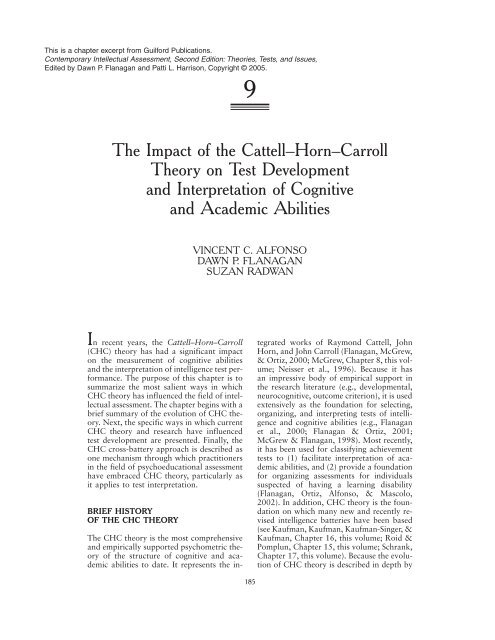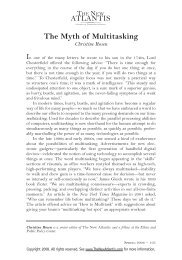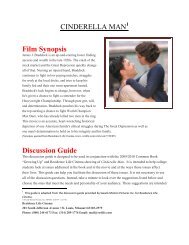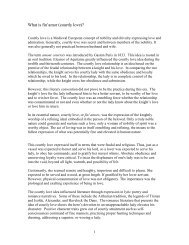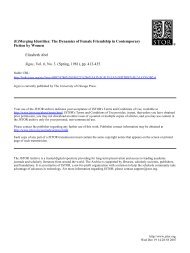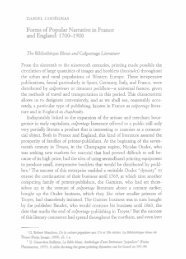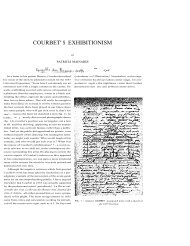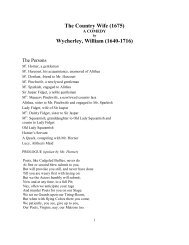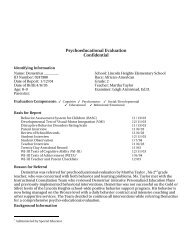The Impact of the Cattell–Horn–Carroll Theory on Test Development ...
The Impact of the Cattell–Horn–Carroll Theory on Test Development ...
The Impact of the Cattell–Horn–Carroll Theory on Test Development ...
Create successful ePaper yourself
Turn your PDF publications into a flip-book with our unique Google optimized e-Paper software.
This is a chapter excerpt from Guilford Publicati<strong>on</strong>s.<br />
C<strong>on</strong>temporary Intellectual Assessment, Sec<strong>on</strong>d Editi<strong>on</strong>: <str<strong>on</strong>g>The</str<strong>on</strong>g>ories, <strong>Test</strong>s, and Issues,<br />
Edited by Dawn P. Flanagan and Patti L. Harris<strong>on</strong>, Copyright © 2005.<br />
9<br />
<str<strong>on</strong>g>The</str<strong>on</strong>g> <str<strong>on</strong>g>Impact</str<strong>on</strong>g> <str<strong>on</strong>g>of</str<strong>on</strong>g> <str<strong>on</strong>g>the</str<strong>on</strong>g> <str<strong>on</strong>g>Cattell–Horn–Carroll</str<strong>on</strong>g><br />
<str<strong>on</strong>g>The</str<strong>on</strong>g>ory <strong>on</strong> <strong>Test</strong> <strong>Development</strong><br />
and Interpretati<strong>on</strong> <str<strong>on</strong>g>of</str<strong>on</strong>g> Cognitive<br />
and Academic Abilities<br />
In recent years, <str<strong>on</strong>g>the</str<strong>on</strong>g> <str<strong>on</strong>g>Cattell–Horn–Carroll</str<strong>on</strong>g><br />
(CHC) <str<strong>on</strong>g>the</str<strong>on</strong>g>ory has had a significant impact<br />
<strong>on</strong> <str<strong>on</strong>g>the</str<strong>on</strong>g> measurement <str<strong>on</strong>g>of</str<strong>on</strong>g> cognitive abilities<br />
and <str<strong>on</strong>g>the</str<strong>on</strong>g> interpretati<strong>on</strong> <str<strong>on</strong>g>of</str<strong>on</strong>g> intelligence test performance.<br />
<str<strong>on</strong>g>The</str<strong>on</strong>g> purpose <str<strong>on</strong>g>of</str<strong>on</strong>g> this chapter is to<br />
summarize <str<strong>on</strong>g>the</str<strong>on</strong>g> most salient ways in which<br />
CHC <str<strong>on</strong>g>the</str<strong>on</strong>g>ory has influenced <str<strong>on</strong>g>the</str<strong>on</strong>g> field <str<strong>on</strong>g>of</str<strong>on</strong>g> intellectual<br />
assessment. <str<strong>on</strong>g>The</str<strong>on</strong>g> chapter begins with a<br />
brief summary <str<strong>on</strong>g>of</str<strong>on</strong>g> <str<strong>on</strong>g>the</str<strong>on</strong>g> evoluti<strong>on</strong> <str<strong>on</strong>g>of</str<strong>on</strong>g> CHC <str<strong>on</strong>g>the</str<strong>on</strong>g>ory.<br />
Next, <str<strong>on</strong>g>the</str<strong>on</strong>g> specific ways in which current<br />
CHC <str<strong>on</strong>g>the</str<strong>on</strong>g>ory and research have influenced<br />
test development are presented. Finally, <str<strong>on</strong>g>the</str<strong>on</strong>g><br />
CHC cross-battery approach is described as<br />
<strong>on</strong>e mechanism through which practiti<strong>on</strong>ers<br />
in <str<strong>on</strong>g>the</str<strong>on</strong>g> field <str<strong>on</strong>g>of</str<strong>on</strong>g> psychoeducati<strong>on</strong>al assessment<br />
have embraced CHC <str<strong>on</strong>g>the</str<strong>on</strong>g>ory, particularly as<br />
it applies to test interpretati<strong>on</strong>.<br />
BRIEF HISTORY<br />
OF THE CHC THEORY<br />
<str<strong>on</strong>g>The</str<strong>on</strong>g> CHC <str<strong>on</strong>g>the</str<strong>on</strong>g>ory is <str<strong>on</strong>g>the</str<strong>on</strong>g> most comprehensive<br />
and empirically supported psychometric <str<strong>on</strong>g>the</str<strong>on</strong>g>ory<br />
<str<strong>on</strong>g>of</str<strong>on</strong>g> <str<strong>on</strong>g>the</str<strong>on</strong>g> structure <str<strong>on</strong>g>of</str<strong>on</strong>g> cognitive and academic<br />
abilities to date. It represents <str<strong>on</strong>g>the</str<strong>on</strong>g> in-<br />
VINCENT C. ALFONSO<br />
DAWN P. FLANAGAN<br />
SUZAN RADWAN<br />
185<br />
tegrated works <str<strong>on</strong>g>of</str<strong>on</strong>g> Raym<strong>on</strong>d Cattell, John<br />
Horn, and John Carroll (Flanagan, McGrew,<br />
& Ortiz, 2000; McGrew, Chapter 8, this volume;<br />
Neisser et al., 1996). Because it has<br />
an impressive body <str<strong>on</strong>g>of</str<strong>on</strong>g> empirical support in<br />
<str<strong>on</strong>g>the</str<strong>on</strong>g> research literature (e.g., developmental,<br />
neurocognitive, outcome criteri<strong>on</strong>), it is used<br />
extensively as <str<strong>on</strong>g>the</str<strong>on</strong>g> foundati<strong>on</strong> for selecting,<br />
organizing, and interpreting tests <str<strong>on</strong>g>of</str<strong>on</strong>g> intelligence<br />
and cognitive abilities (e.g., Flanagan<br />
et al., 2000; Flanagan & Ortiz, 2001;<br />
McGrew & Flanagan, 1998). Most recently,<br />
it has been used for classifying achievement<br />
tests to (1) facilitate interpretati<strong>on</strong> <str<strong>on</strong>g>of</str<strong>on</strong>g> academic<br />
abilities, and (2) provide a foundati<strong>on</strong><br />
for organizing assessments for individuals<br />
suspected <str<strong>on</strong>g>of</str<strong>on</strong>g> having a learning disability<br />
(Flanagan, Ortiz, Alf<strong>on</strong>so, & Mascolo,<br />
2002). In additi<strong>on</strong>, CHC <str<strong>on</strong>g>the</str<strong>on</strong>g>ory is <str<strong>on</strong>g>the</str<strong>on</strong>g> foundati<strong>on</strong><br />
<strong>on</strong> which many new and recently revised<br />
intelligence batteries have been based<br />
(see Kaufman, Kaufman, Kaufman-Singer, &<br />
Kaufman, Chapter 16, this volume; Roid &<br />
Pomplun, Chapter 15, this volume; Schrank,<br />
Chapter 17, this volume). Because <str<strong>on</strong>g>the</str<strong>on</strong>g> evoluti<strong>on</strong><br />
<str<strong>on</strong>g>of</str<strong>on</strong>g> CHC <str<strong>on</strong>g>the</str<strong>on</strong>g>ory is described in depth by
186 INTERPRETIVE APPROACHES<br />
McGrew (Chapter 8, this volume) and Horn<br />
and Blanks<strong>on</strong> (Chapter 3, this volume), <strong>on</strong>ly<br />
a brief overview is presented here.<br />
Original Gf-Gc <str<strong>on</strong>g>The</str<strong>on</strong>g>ory:<br />
First Precursor to CHC <str<strong>on</strong>g>The</str<strong>on</strong>g>ory<br />
<str<strong>on</strong>g>The</str<strong>on</strong>g> original Gf-Gc <str<strong>on</strong>g>the</str<strong>on</strong>g>ory was a dichotomous<br />
c<strong>on</strong>ceptualizati<strong>on</strong> <str<strong>on</strong>g>of</str<strong>on</strong>g> human cognitive<br />
ability put forth by Raym<strong>on</strong>d Cattell in <str<strong>on</strong>g>the</str<strong>on</strong>g><br />
early 1940s. Cattell based his <str<strong>on</strong>g>the</str<strong>on</strong>g>ory <strong>on</strong> <str<strong>on</strong>g>the</str<strong>on</strong>g><br />
factor-analytic work <str<strong>on</strong>g>of</str<strong>on</strong>g> Thurst<strong>on</strong>e c<strong>on</strong>ducted<br />
in <str<strong>on</strong>g>the</str<strong>on</strong>g> 1930s. Cattell believed that fluid intelligence<br />
(Gf) included inductive and deductive<br />
reas<strong>on</strong>ing abilities that were influenced by<br />
biological and neurological factors, as well<br />
as incidental learning through interacti<strong>on</strong><br />
with <str<strong>on</strong>g>the</str<strong>on</strong>g> envir<strong>on</strong>ment. He postulated fur<str<strong>on</strong>g>the</str<strong>on</strong>g>r<br />
that crystallized intelligence (Gc) c<strong>on</strong>sisted<br />
primarily <str<strong>on</strong>g>of</str<strong>on</strong>g> acquired knowledge abilities<br />
that reflected, to a large extent, <str<strong>on</strong>g>the</str<strong>on</strong>g> influences<br />
<str<strong>on</strong>g>of</str<strong>on</strong>g> acculturati<strong>on</strong> (Cattell, 1957, 1971).<br />
In 1965, John Horn expanded <str<strong>on</strong>g>the</str<strong>on</strong>g> dichotomous<br />
Gf-Gc model to include four additi<strong>on</strong>al<br />
abilities, including visual percepti<strong>on</strong><br />
or processing (Gv), short-term memory<br />
(short-term acquisiti<strong>on</strong> and retrieval—SAR<br />
or Gsm), l<strong>on</strong>g-term storage and retrieval<br />
(tertiary storage and retrieval—TSR or Glr),<br />
and speed <str<strong>on</strong>g>of</str<strong>on</strong>g> processing (Gs). Later he added<br />
auditory processing ability (Ga) to <str<strong>on</strong>g>the</str<strong>on</strong>g> <str<strong>on</strong>g>the</str<strong>on</strong>g>oretical<br />
model and refined <str<strong>on</strong>g>the</str<strong>on</strong>g> definiti<strong>on</strong>s<br />
<str<strong>on</strong>g>of</str<strong>on</strong>g> Gv, Gs, and Glr (Horn, 1968; Horn &<br />
Stankov, 1982).<br />
In <str<strong>on</strong>g>the</str<strong>on</strong>g> early 1990s, Horn added a factor<br />
representing an individual’s quickness in reacting<br />
(reacti<strong>on</strong> time) and making decisi<strong>on</strong>s<br />
(decisi<strong>on</strong> speed). <str<strong>on</strong>g>The</str<strong>on</strong>g> abbreviati<strong>on</strong> for this<br />
factor is Gt (Horn, 1991). Finally, factors for<br />
quantitative ability (Gq) and broad reading/<br />
writing ability (Gw) were added to <str<strong>on</strong>g>the</str<strong>on</strong>g><br />
model, based <strong>on</strong> <str<strong>on</strong>g>the</str<strong>on</strong>g> research <str<strong>on</strong>g>of</str<strong>on</strong>g> Horn (e.g.,<br />
1991) and Woodcock (1994), respectively.<br />
Based largely <strong>on</strong> <str<strong>on</strong>g>the</str<strong>on</strong>g> results <str<strong>on</strong>g>of</str<strong>on</strong>g> Horn’s thinking<br />
and research, Gf-Gc <str<strong>on</strong>g>the</str<strong>on</strong>g>ory expanded<br />
into an eight-factor model that became<br />
known as <str<strong>on</strong>g>the</str<strong>on</strong>g> Cattell–Horn Gf-Gc <str<strong>on</strong>g>the</str<strong>on</strong>g>ory<br />
(Horn, 1991; see also Horn & Blanks<strong>on</strong>,<br />
Chapter 3, this volume).<br />
Carroll’s Three-Stratum <str<strong>on</strong>g>The</str<strong>on</strong>g>ory:<br />
Sec<strong>on</strong>d Precursor to CHC <str<strong>on</strong>g>The</str<strong>on</strong>g>ory<br />
In his seminal review <str<strong>on</strong>g>of</str<strong>on</strong>g> <str<strong>on</strong>g>the</str<strong>on</strong>g> world’s literature<br />
<strong>on</strong> human cognitive abilities, Carroll (1993)<br />
proposed that <str<strong>on</strong>g>the</str<strong>on</strong>g> structure <str<strong>on</strong>g>of</str<strong>on</strong>g> cognitive abilities<br />
could be understood best via three strata<br />
that differ in breadth and generality. <str<strong>on</strong>g>The</str<strong>on</strong>g><br />
broadest and most general level <str<strong>on</strong>g>of</str<strong>on</strong>g> ability is<br />
represented by stratum III. According to<br />
Carroll, stratum III represents a general factor<br />
c<strong>on</strong>sistent with Spearman’s (1927) c<strong>on</strong>cept<br />
<str<strong>on</strong>g>of</str<strong>on</strong>g> g and subsumes both broad (stratum<br />
II) and narrow (stratum I) abilities. <str<strong>on</strong>g>The</str<strong>on</strong>g> various<br />
broad (stratum II) abilities, are denoted<br />
with an uppercase G followed by a lowercase<br />
letter (e.g., Gf and Gc). <str<strong>on</strong>g>The</str<strong>on</strong>g> eight broad<br />
abilities included in Carroll’s <str<strong>on</strong>g>the</str<strong>on</strong>g>ory subsume<br />
a large number <str<strong>on</strong>g>of</str<strong>on</strong>g> narrow (stratum I) abilities<br />
(Carroll, 1993; see also Carroll, Chapter<br />
4, this volume). 1<br />
<str<strong>on</strong>g>The</str<strong>on</strong>g> Cattell–Horn and Carroll <str<strong>on</strong>g>The</str<strong>on</strong>g>ories:<br />
Similarities and Differences<br />
Figure 9.1 includes <str<strong>on</strong>g>the</str<strong>on</strong>g> Cattell–Horn Gf-Gc<br />
<str<strong>on</strong>g>the</str<strong>on</strong>g>ory and Carroll’s three-stratum <str<strong>on</strong>g>the</str<strong>on</strong>g>ory<br />
(without <str<strong>on</strong>g>the</str<strong>on</strong>g> narrow abilities). <str<strong>on</strong>g>The</str<strong>on</strong>g>se <str<strong>on</strong>g>the</str<strong>on</strong>g>ories<br />
are presented toge<str<strong>on</strong>g>the</str<strong>on</strong>g>r in order to highlight<br />
<str<strong>on</strong>g>the</str<strong>on</strong>g> most salient similarities and differences<br />
between <str<strong>on</strong>g>the</str<strong>on</strong>g>m. Each <str<strong>on</strong>g>the</str<strong>on</strong>g>ory posits that <str<strong>on</strong>g>the</str<strong>on</strong>g>re<br />
are multiple broad (stratum II) abilities, and<br />
for <str<strong>on</strong>g>the</str<strong>on</strong>g> most part, <str<strong>on</strong>g>the</str<strong>on</strong>g> names and abbreviati<strong>on</strong>s<br />
associated with <str<strong>on</strong>g>the</str<strong>on</strong>g>se abilities are similar<br />
or identical. Briefly, <str<strong>on</strong>g>the</str<strong>on</strong>g>re are four major<br />
structural differences between <str<strong>on</strong>g>the</str<strong>on</strong>g> Carroll<br />
and Cattell–Horn <str<strong>on</strong>g>the</str<strong>on</strong>g>ories. First, Carroll’s<br />
<str<strong>on</strong>g>the</str<strong>on</strong>g>ory includes a general ability factor (stratum<br />
III); <str<strong>on</strong>g>the</str<strong>on</strong>g> Cattell–Horn <str<strong>on</strong>g>the</str<strong>on</strong>g>ory does not.<br />
Sec<strong>on</strong>d, <str<strong>on</strong>g>the</str<strong>on</strong>g> Cattell–Horn <str<strong>on</strong>g>the</str<strong>on</strong>g>ory includes<br />
quantitative knowledge and quantitative reas<strong>on</strong>ing<br />
as a separate broad ability (i.e., Gq),<br />
whereas Carroll’s <str<strong>on</strong>g>the</str<strong>on</strong>g>ory includes quantitative<br />
reas<strong>on</strong>ing as a narrow ability subsumed<br />
by Gf. This difference is depicted in Figure<br />
9.1 by <str<strong>on</strong>g>the</str<strong>on</strong>g> arrow that leads from Gq in<br />
<str<strong>on</strong>g>the</str<strong>on</strong>g> Cattell–Horn <str<strong>on</strong>g>the</str<strong>on</strong>g>ory to Gf in Carroll’s<br />
<str<strong>on</strong>g>the</str<strong>on</strong>g>ory. Third, <str<strong>on</strong>g>the</str<strong>on</strong>g> Cattell–Horn <str<strong>on</strong>g>the</str<strong>on</strong>g>ory includes<br />
a broad reading/writing (Grw) factor;<br />
Carroll’s <str<strong>on</strong>g>the</str<strong>on</strong>g>ory includes reading and writing<br />
as narrow abilities subsumed by Gc. This difference<br />
is depicted in Figure 9.1 by <str<strong>on</strong>g>the</str<strong>on</strong>g> arrow<br />
that leads from Grw in <str<strong>on</strong>g>the</str<strong>on</strong>g> Cattell–Horn<br />
<str<strong>on</strong>g>the</str<strong>on</strong>g>ory to Gc in Carroll’s <str<strong>on</strong>g>the</str<strong>on</strong>g>ory. Fourth,<br />
Carroll’s <str<strong>on</strong>g>the</str<strong>on</strong>g>ory includes short-term memory<br />
with o<str<strong>on</strong>g>the</str<strong>on</strong>g>r memory abilities, such as associative<br />
memory, meaningful memory, and freerecall<br />
memory, under Gy in Figure 9.1;<br />
<str<strong>on</strong>g>the</str<strong>on</strong>g> Cattell–Horn <str<strong>on</strong>g>the</str<strong>on</strong>g>ory separates shortterm<br />
memory (Gsm) from associative mem-
CHC <str<strong>on</strong>g>The</str<strong>on</strong>g>ory’s <str<strong>on</strong>g>Impact</str<strong>on</strong>g> <strong>on</strong> <strong>Test</strong> <strong>Development</strong>/Interpretati<strong>on</strong> 187<br />
FIGURE 9.1. Comparis<strong>on</strong> <str<strong>on</strong>g>of</str<strong>on</strong>g> Cattell–Horn Gf-Gc and Carroll three-stratum <str<strong>on</strong>g>the</str<strong>on</strong>g>ories. Narrow abilities<br />
are omitted from this figure. From Flanagan, Ortiz, Alf<strong>on</strong>so, and Mascolo (2002). Published by Allyn<br />
and Bac<strong>on</strong>, Bost<strong>on</strong>, MA. Copyright © 2002 by Pears<strong>on</strong> Educati<strong>on</strong>. Reprinted by permissi<strong>on</strong>.
188 INTERPRETIVE APPROACHES<br />
ory, meaningful memory, and free-recall<br />
memory, because <str<strong>on</strong>g>the</str<strong>on</strong>g> latter abilities are purported<br />
to measure l<strong>on</strong>g-term retrieval (Glr in<br />
Figure 9.1). Notwithstanding <str<strong>on</strong>g>the</str<strong>on</strong>g>se differences,<br />
Carroll (1993) c<strong>on</strong>cluded that <str<strong>on</strong>g>the</str<strong>on</strong>g><br />
Cattell–Horn Gf-Gc <str<strong>on</strong>g>the</str<strong>on</strong>g>ory represents <str<strong>on</strong>g>the</str<strong>on</strong>g><br />
most reas<strong>on</strong>able approach to <str<strong>on</strong>g>the</str<strong>on</strong>g> structure <str<strong>on</strong>g>of</str<strong>on</strong>g><br />
cognitive abilities currently available.<br />
Current CHC <str<strong>on</strong>g>The</str<strong>on</strong>g>ory<br />
In <str<strong>on</strong>g>the</str<strong>on</strong>g> late 1990s, McGrew (1997) attempted<br />
to resolve differences between <str<strong>on</strong>g>the</str<strong>on</strong>g> Cattell–<br />
Horn and Carroll models <strong>on</strong> <str<strong>on</strong>g>the</str<strong>on</strong>g> basis <str<strong>on</strong>g>of</str<strong>on</strong>g><br />
his research. McGrew proposed an “integrated”<br />
Gf-Gc <str<strong>on</strong>g>the</str<strong>on</strong>g>ory in Flanagan and colleagues<br />
(2000). This integrated <str<strong>on</strong>g>the</str<strong>on</strong>g>ory became<br />
known as <str<strong>on</strong>g>the</str<strong>on</strong>g> <str<strong>on</strong>g>Cattell–Horn–Carroll</str<strong>on</strong>g><br />
(CHC) <str<strong>on</strong>g>the</str<strong>on</strong>g>ory <str<strong>on</strong>g>of</str<strong>on</strong>g> cognitive abilities shortly<br />
<str<strong>on</strong>g>the</str<strong>on</strong>g>reafter (see McGrew, Chapter 8, this volume,<br />
for details). CHC <str<strong>on</strong>g>the</str<strong>on</strong>g>ory is depicted in<br />
Figure 9.2. This figure shows that CHC <str<strong>on</strong>g>the</str<strong>on</strong>g>ory<br />
currently c<strong>on</strong>sists <str<strong>on</strong>g>of</str<strong>on</strong>g> 10 broad cognitive<br />
abilities and more than 70 narrow abilities.<br />
<str<strong>on</strong>g>The</str<strong>on</strong>g> CHC <str<strong>on</strong>g>the</str<strong>on</strong>g>ory presented in Figure 9.2<br />
omits a g or general ability factor, primarily<br />
because <str<strong>on</strong>g>the</str<strong>on</strong>g> utility <str<strong>on</strong>g>of</str<strong>on</strong>g> <str<strong>on</strong>g>the</str<strong>on</strong>g> <str<strong>on</strong>g>the</str<strong>on</strong>g>ory (as it is employed<br />
in assessment-related disciplines) is in<br />
clarifying individual cognitive and academic<br />
strengths and weaknesses, which are understood<br />
best through <str<strong>on</strong>g>the</str<strong>on</strong>g> operati<strong>on</strong>alizati<strong>on</strong> <str<strong>on</strong>g>of</str<strong>on</strong>g><br />
broad (stratum II) and narrow (stratum I)<br />
abilities (Flanagan & Ortiz, 2001). O<str<strong>on</strong>g>the</str<strong>on</strong>g>rs,<br />
however, believe that g is <str<strong>on</strong>g>the</str<strong>on</strong>g> most important<br />
ability to assess because it predicts <str<strong>on</strong>g>the</str<strong>on</strong>g> li<strong>on</strong>’s<br />
share <str<strong>on</strong>g>of</str<strong>on</strong>g> <str<strong>on</strong>g>the</str<strong>on</strong>g> variance in multiple outcomes,<br />
both academic and occupati<strong>on</strong>al (e.g., Glutting,<br />
Watkins, & Youngstrom, 2003). Notwithstanding<br />
<strong>on</strong>e’s positi<strong>on</strong> <strong>on</strong> <str<strong>on</strong>g>the</str<strong>on</strong>g> importance <str<strong>on</strong>g>of</str<strong>on</strong>g><br />
g in understanding various outcomes (particularly<br />
academic), <str<strong>on</strong>g>the</str<strong>on</strong>g>re is c<strong>on</strong>siderable evidence<br />
that both broad and narrow CHC cognitive<br />
abilities explain a significant porti<strong>on</strong><br />
<str<strong>on</strong>g>of</str<strong>on</strong>g> variance in specific academic abilities,<br />
over and above <str<strong>on</strong>g>the</str<strong>on</strong>g> variance accounted for<br />
by g (e.g., McGrew, Flanagan, Keith, &<br />
Vanderwood, 1997; Vanderwood, McGrew,<br />
Flanagan, & Keith, 2002).<br />
<str<strong>on</strong>g>The</str<strong>on</strong>g> various revisi<strong>on</strong>s <str<strong>on</strong>g>of</str<strong>on</strong>g> and refinements<br />
to <str<strong>on</strong>g>the</str<strong>on</strong>g> <str<strong>on</strong>g>the</str<strong>on</strong>g>ory <str<strong>on</strong>g>of</str<strong>on</strong>g> fluid and crystallized intelligence<br />
over <str<strong>on</strong>g>the</str<strong>on</strong>g> past several decades, al<strong>on</strong>g<br />
with its mounting network <str<strong>on</strong>g>of</str<strong>on</strong>g> validity evidence,<br />
<strong>on</strong>ly began to influence intelligence<br />
test development recently—in <str<strong>on</strong>g>the</str<strong>on</strong>g> middle to<br />
late 1980s. Today, however, nearly every in-<br />
telligence test developer acknowledges <str<strong>on</strong>g>the</str<strong>on</strong>g><br />
importance <str<strong>on</strong>g>of</str<strong>on</strong>g> CHC <str<strong>on</strong>g>the</str<strong>on</strong>g>ory in defining and<br />
interpreting cognitive ability c<strong>on</strong>structs, and<br />
most have used this <str<strong>on</strong>g>the</str<strong>on</strong>g>ory to guide directly<br />
<str<strong>on</strong>g>the</str<strong>on</strong>g> development <str<strong>on</strong>g>of</str<strong>on</strong>g> <str<strong>on</strong>g>the</str<strong>on</strong>g>ir intelligence tests.<br />
<str<strong>on</strong>g>The</str<strong>on</strong>g> increased importance given to CHC <str<strong>on</strong>g>the</str<strong>on</strong>g>ory<br />
in intelligence test development is summarized<br />
next.<br />
INTELLIGENCE TESTS<br />
PUBLISHED PRIOR TO 1998:<br />
WHAT ABILITIES WERE MEASURED?<br />
Although <str<strong>on</strong>g>the</str<strong>on</strong>g>re was substantial evidence <str<strong>on</strong>g>of</str<strong>on</strong>g><br />
at least eight or nine broad cognitive Gf-Gc<br />
abilities by <str<strong>on</strong>g>the</str<strong>on</strong>g> late 1980s, <str<strong>on</strong>g>the</str<strong>on</strong>g> tests <str<strong>on</strong>g>of</str<strong>on</strong>g> <str<strong>on</strong>g>the</str<strong>on</strong>g><br />
time did not reflect this diversity in measurement.<br />
Table 9.1 shows <str<strong>on</strong>g>the</str<strong>on</strong>g> intelligence batteries<br />
that were published between 1981 and<br />
1997. <str<strong>on</strong>g>The</str<strong>on</strong>g> informati<strong>on</strong> presented in this table<br />
was derived from a series <str<strong>on</strong>g>of</str<strong>on</strong>g> joint factor<br />
analyses c<strong>on</strong>ducted by Woodcock (1990)<br />
and o<str<strong>on</strong>g>the</str<strong>on</strong>g>rs (Carroll, 1993; Flanagan &<br />
McGrew, 1997; Horn, 1991; Keith, 1997;<br />
Keith, Kranzler, & Flanagan, 2001; McGrew,<br />
1997; Phelps, McGrew, Knopik, & Ford, in<br />
press). As Table 9.1 shows, <str<strong>on</strong>g>the</str<strong>on</strong>g> majority <str<strong>on</strong>g>of</str<strong>on</strong>g><br />
tests published prior to 1998 measured <strong>on</strong>ly<br />
two or three broad cognitive abilities well<br />
(i.e., included two or more measures <str<strong>on</strong>g>of</str<strong>on</strong>g> <str<strong>on</strong>g>the</str<strong>on</strong>g><br />
broad ability). For example, this table shows<br />
that <str<strong>on</strong>g>the</str<strong>on</strong>g> Wechsler Preschool and Primary<br />
Scale <str<strong>on</strong>g>of</str<strong>on</strong>g> Intelligence—Revised (WPPSI-<br />
R), <str<strong>on</strong>g>the</str<strong>on</strong>g> Kaufman Assessment Battery for<br />
Children (K-ABC), <str<strong>on</strong>g>the</str<strong>on</strong>g> Kaufman Adolescent<br />
and Adult Intelligence <strong>Test</strong> (KAIT), <str<strong>on</strong>g>the</str<strong>on</strong>g><br />
Wechsler Adult Intelligence Scale—Revised<br />
(WAIS-R), and <str<strong>on</strong>g>the</str<strong>on</strong>g> Cognitive Assessment<br />
System (CAS) batteries <strong>on</strong>ly measured two<br />
or three broad CHC abilities adequately. <str<strong>on</strong>g>The</str<strong>on</strong>g><br />
WPPSI-R primarily measured Gv and Gc.<br />
<str<strong>on</strong>g>The</str<strong>on</strong>g> K-ABC primarily measured Gv and<br />
Gsm, and to a much lesser extent Gf, while<br />
<str<strong>on</strong>g>the</str<strong>on</strong>g> KAIT primarily measured Gc and Glr,<br />
and to a much lesser extent Gf and Gv. <str<strong>on</strong>g>The</str<strong>on</strong>g><br />
CAS measured Gs, Gsm, and Gv. Finally,<br />
while <str<strong>on</strong>g>the</str<strong>on</strong>g> Differential Ability Scales (DAS),<br />
<str<strong>on</strong>g>the</str<strong>on</strong>g> Stanford–Binet Intelligence Scale: Fourth<br />
Editi<strong>on</strong> (SB-IV), and <str<strong>on</strong>g>the</str<strong>on</strong>g> Wechsler Intelligence<br />
Scale for Children—Third Editi<strong>on</strong><br />
(WISC-III) did not provide sufficient coverage<br />
<str<strong>on</strong>g>of</str<strong>on</strong>g> abilities to narrow <str<strong>on</strong>g>the</str<strong>on</strong>g> gap between<br />
c<strong>on</strong>temporary <str<strong>on</strong>g>the</str<strong>on</strong>g>ory and practice, <str<strong>on</strong>g>the</str<strong>on</strong>g>ir<br />
comprehensive measurement <str<strong>on</strong>g>of</str<strong>on</strong>g> approxi-
189<br />
FIGURE 9.2. <str<strong>on</strong>g>The</str<strong>on</strong>g> <str<strong>on</strong>g>Cattell–Horn–Carroll</str<strong>on</strong>g> (CHC) <str<strong>on</strong>g>the</str<strong>on</strong>g>ory <str<strong>on</strong>g>of</str<strong>on</strong>g> cognitive abilities. Italic type indicates abilities that were not included in Carroll’s three-stratum <str<strong>on</strong>g>the</str<strong>on</strong>g>ory,<br />
but were included by Carroll in <str<strong>on</strong>g>the</str<strong>on</strong>g> domains <str<strong>on</strong>g>of</str<strong>on</strong>g> knowledge and achievement. Boldface type indicates abilities that are placed under different CHC broad abilities<br />
than in Carroll’s <str<strong>on</strong>g>the</str<strong>on</strong>g>ory. <str<strong>on</strong>g>The</str<strong>on</strong>g>se changes are based <strong>on</strong> <str<strong>on</strong>g>the</str<strong>on</strong>g> Cattell–Horn <str<strong>on</strong>g>the</str<strong>on</strong>g>ory and/or recent research (see Flanagan et al., 2000; Flanagan & Ortiz, 2001; McGrew,<br />
1997; McGrew & Flanagan, 1998). From Flanagan, Ortiz, Alf<strong>on</strong>so, and Mascolo (2002). Published by Allyn and Bac<strong>on</strong>, Bost<strong>on</strong>, MA. Copyright © 2002 by<br />
Pears<strong>on</strong> Educati<strong>on</strong>. Reprinted by permissi<strong>on</strong>.
TABLE 9.1. Representati<strong>on</strong> <str<strong>on</strong>g>of</str<strong>on</strong>g> Broad CHC Abilities <strong>on</strong> Nine Intelligence Batteries Published Prior to 1998<br />
Battery Gf Gc Gv Gsm Glr Ga Gs<br />
Digit Span — — Symbol Search<br />
Coding<br />
Block Design<br />
Object Assembly<br />
Picture<br />
Arrangement<br />
Picture Completi<strong>on</strong><br />
Mazes<br />
WISC-III — Vocabulary<br />
Informati<strong>on</strong><br />
Similarities<br />
Comprehensi<strong>on</strong><br />
Digit Span — — Digit–Symbol<br />
Block Design<br />
Object Assembly<br />
Picture Completi<strong>on</strong><br />
Picture<br />
Arrangement<br />
WAIS-R — Vocabulary<br />
Informati<strong>on</strong><br />
Similarities<br />
Comprehensi<strong>on</strong><br />
Sentences — — Animal Pegs<br />
Block Design<br />
Object Assembly<br />
Picture Completi<strong>on</strong><br />
Mazes<br />
Geometric Design<br />
WPPSI-R — Vocabulary<br />
Informati<strong>on</strong><br />
Similarities<br />
Comprehensi<strong>on</strong><br />
190<br />
— —<br />
— Rebus Learning<br />
Rebus Delayed<br />
Recall<br />
Auditory Delayed<br />
Recall<br />
Memory for Block<br />
Designs<br />
Definiti<strong>on</strong>s<br />
Famous Faces<br />
Auditory<br />
Comprehensi<strong>on</strong><br />
Double Meanings<br />
KAIT Mystery Codes<br />
Logical Steps<br />
— — —<br />
Number Recall<br />
Word Order<br />
K-ABC Matrix Analogies — Triangles<br />
Face Recogniti<strong>on</strong><br />
Gestalt Closure<br />
Magic Window<br />
Hand Movements<br />
Spatial Memory<br />
Photo Series<br />
— — Matching Numbers<br />
Receptive Attenti<strong>on</strong><br />
Planned Codes<br />
Word Series<br />
Sentence<br />
Repetiti<strong>on</strong><br />
CAS — — Figure Memory<br />
Verbal Spatial<br />
Relati<strong>on</strong>s
Sentence Questi<strong>on</strong>s Number Detecti<strong>on</strong><br />
Planned<br />
C<strong>on</strong>necti<strong>on</strong>s<br />
Expressive<br />
Attenti<strong>on</strong><br />
N<strong>on</strong>verbal<br />
Matrices<br />
Recall <str<strong>on</strong>g>of</str<strong>on</strong>g> Digits Recall <str<strong>on</strong>g>of</str<strong>on</strong>g> Objects — Speed <str<strong>on</strong>g>of</str<strong>on</strong>g><br />
Informati<strong>on</strong><br />
Processing<br />
Pattern<br />
C<strong>on</strong>structi<strong>on</strong><br />
Block Building<br />
Copying<br />
Matching Letter-<br />
Like Forms<br />
Recall <str<strong>on</strong>g>of</str<strong>on</strong>g> Designs<br />
Recogniti<strong>on</strong> <str<strong>on</strong>g>of</str<strong>on</strong>g><br />
Pictures<br />
Similarities<br />
Verbal<br />
Comprehensi<strong>on</strong><br />
Word Definiti<strong>on</strong>s<br />
Naming<br />
Vocabulary<br />
DAS Matrices<br />
Picture Similarities<br />
Sequential and<br />
Quantitative<br />
Reas<strong>on</strong>ing<br />
Visual Matching<br />
Cross Out<br />
Incomplete Words<br />
Sound Blending<br />
Sound Patterns<br />
Memory for<br />
Names<br />
Visual–Auditory<br />
Learning<br />
Delayed Recall:<br />
Memory for<br />
Names<br />
Delayed Recall:<br />
Visual–Auditory<br />
Learning<br />
Memory for Words<br />
Memory for<br />
Sentences<br />
Numbers Reversed<br />
Spatial Relati<strong>on</strong>s<br />
Picture<br />
Recogniti<strong>on</strong><br />
Visual Closure<br />
Oral Vocabulary<br />
Picture Vocabulary<br />
Listening<br />
Comprehensi<strong>on</strong><br />
Verbal Analogies<br />
WJ-R C<strong>on</strong>cept Formati<strong>on</strong><br />
Analysis–Syn<str<strong>on</strong>g>the</str<strong>on</strong>g>sis<br />
191<br />
— — —<br />
Memory for<br />
Sentences<br />
Memory for Digits<br />
Pattern Analysis<br />
Bead Memory<br />
Copying<br />
Memory for<br />
Objects<br />
Paper Folding and<br />
Cutting<br />
Verbal Relati<strong>on</strong>s<br />
Comprehensi<strong>on</strong><br />
Absurdities<br />
Vocabulary<br />
SB-IV Matrices<br />
Equati<strong>on</strong> Building<br />
Number Series<br />
Note. CHC classificati<strong>on</strong>s are based <strong>on</strong> <str<strong>on</strong>g>the</str<strong>on</strong>g> extant literature and primary sources such as Woodcock (1990), Horn (1991), Carroll (1993), McGrew (1997), and McGrew and Flanagan (1998).<br />
WISC-III, Wechsler Intelligence Scale for Children—Third Editi<strong>on</strong> (Wechsler, 1991); WAIS-R, Wechsler Adult Intelligence Scale—Revised (Wechsler, 1981); WPPSI-R, Wechsler Preschool and Primary<br />
Scale <str<strong>on</strong>g>of</str<strong>on</strong>g> Intelligence—Revised (Wechsler, 1989); KAIT, Kaufman Adolescent and Adult Intelligence <strong>Test</strong> (Kaufman & Kaufman, 1993); K-ABC, Kaufman Assessment Battery for Children<br />
(Kaufman & Kaufman, 1983); CAS, Cognitive Assessment System (Das & Naglieri, 1997); DAS, Differential Ability Scales (Elliott, 1990); WJ-R, Woodcock–Johns<strong>on</strong> Psycho-Educati<strong>on</strong>al Battery—Revised<br />
(Woodcock & Johns<strong>on</strong>, 1989); SB-IV, Stanford–Binet Intelligence Scale: Fourth Editi<strong>on</strong> (Thorndike, Hagen, & Sattler, 1986).
192 INTERPRETIVE APPROACHES<br />
mately four CHC abilities, as depicted in Table<br />
9.1, was n<strong>on</strong>e<str<strong>on</strong>g>the</str<strong>on</strong>g>less an improvement<br />
over <str<strong>on</strong>g>the</str<strong>on</strong>g> above-menti<strong>on</strong>ed batteries. Table<br />
9.1 shows that <strong>on</strong>ly <str<strong>on</strong>g>the</str<strong>on</strong>g> Woodcock–Johns<strong>on</strong><br />
Psycho-Educati<strong>on</strong>al Battery—Revised (WJ-<br />
R) included measures <str<strong>on</strong>g>of</str<strong>on</strong>g> all broad cognitive<br />
abilities listed in <str<strong>on</strong>g>the</str<strong>on</strong>g> table. Never<str<strong>on</strong>g>the</str<strong>on</strong>g>less,<br />
most <str<strong>on</strong>g>of</str<strong>on</strong>g> <str<strong>on</strong>g>the</str<strong>on</strong>g> broad abilities were not measured<br />
adequately by <str<strong>on</strong>g>the</str<strong>on</strong>g> WJ-R (McGrew &<br />
Flanagan, 1998).<br />
In general, Table 9.1 shows that Gf, Gsm,<br />
Glr, Ga, and Gs were not measured well by<br />
<str<strong>on</strong>g>the</str<strong>on</strong>g> majority <str<strong>on</strong>g>of</str<strong>on</strong>g> intelligence tests published<br />
prior to 1998. <str<strong>on</strong>g>The</str<strong>on</strong>g>refore, it is clear that most<br />
test authors did not use <str<strong>on</strong>g>the</str<strong>on</strong>g> <str<strong>on</strong>g>the</str<strong>on</strong>g>ory <str<strong>on</strong>g>of</str<strong>on</strong>g> fluid<br />
and crystallized intelligence and its corresp<strong>on</strong>ding<br />
research base to guide <str<strong>on</strong>g>the</str<strong>on</strong>g> development<br />
<str<strong>on</strong>g>of</str<strong>on</strong>g> <str<strong>on</strong>g>the</str<strong>on</strong>g>ir intelligence tests. As such, a<br />
substantial <str<strong>on</strong>g>the</str<strong>on</strong>g>ory–practice gap existed; that<br />
is, <str<strong>on</strong>g>the</str<strong>on</strong>g>ories <str<strong>on</strong>g>of</str<strong>on</strong>g> <str<strong>on</strong>g>the</str<strong>on</strong>g> structure <str<strong>on</strong>g>of</str<strong>on</strong>g> cognitive abilities<br />
were far in advance <str<strong>on</strong>g>of</str<strong>on</strong>g> <str<strong>on</strong>g>the</str<strong>on</strong>g> instruments<br />
used to operati<strong>on</strong>alize <str<strong>on</strong>g>the</str<strong>on</strong>g>m. In fact, prior to<br />
<str<strong>on</strong>g>the</str<strong>on</strong>g> mid-1980s, <str<strong>on</strong>g>the</str<strong>on</strong>g>ory seldom played a role<br />
in intelligence test development. <str<strong>on</strong>g>The</str<strong>on</strong>g> numerous<br />
dashes in Table 9.1 exemplify <str<strong>on</strong>g>the</str<strong>on</strong>g><br />
<str<strong>on</strong>g>the</str<strong>on</strong>g>ory–practice gap that existed in <str<strong>on</strong>g>the</str<strong>on</strong>g> field<br />
<str<strong>on</strong>g>of</str<strong>on</strong>g> intellectual assessment at that time.<br />
A METHOD DESIGNED TO NARROW<br />
THE THEORY–PRACTICE GAP:<br />
THE CHC CROSS-BATTERY APPROACH<br />
As a result <str<strong>on</strong>g>of</str<strong>on</strong>g> his findings, Woodcock (1990)<br />
suggested that it might be necessary to<br />
“cross” batteries to measure a broader range<br />
<str<strong>on</strong>g>of</str<strong>on</strong>g> cognitive abilities. As such, <str<strong>on</strong>g>the</str<strong>on</strong>g> findings<br />
presented in Table 9.1 provided <str<strong>on</strong>g>the</str<strong>on</strong>g> impetus<br />
for <str<strong>on</strong>g>the</str<strong>on</strong>g> development <str<strong>on</strong>g>of</str<strong>on</strong>g> <str<strong>on</strong>g>the</str<strong>on</strong>g> cross-battery approach<br />
(McGrew & Flanagan, 1998). This<br />
approach to assessment (currently known as<br />
<str<strong>on</strong>g>the</str<strong>on</strong>g> CHC cross-battery approach, and referred<br />
to hereafter as <str<strong>on</strong>g>the</str<strong>on</strong>g> CB approach) is a<br />
time-efficient method <str<strong>on</strong>g>of</str<strong>on</strong>g> assessment and interpretati<strong>on</strong><br />
that is grounded in CHC <str<strong>on</strong>g>the</str<strong>on</strong>g>ory<br />
and research. <str<strong>on</strong>g>The</str<strong>on</strong>g> CB approach provides a<br />
set <str<strong>on</strong>g>of</str<strong>on</strong>g> principles and procedures that allows<br />
practiti<strong>on</strong>ers to measure a wider range <str<strong>on</strong>g>of</str<strong>on</strong>g><br />
abilities than that represented by most single<br />
intelligence or achievement batteries, in a<br />
<str<strong>on</strong>g>the</str<strong>on</strong>g>oretically and psychometrically defensible<br />
manner. In effect, <str<strong>on</strong>g>the</str<strong>on</strong>g> CB approach was developed<br />
to systematically replace <str<strong>on</strong>g>the</str<strong>on</strong>g> dashes<br />
in Table 9.1 with tests from ano<str<strong>on</strong>g>the</str<strong>on</strong>g>r battery.<br />
As such, this approach guides practiti<strong>on</strong>ers<br />
in <str<strong>on</strong>g>the</str<strong>on</strong>g> selecti<strong>on</strong> <str<strong>on</strong>g>of</str<strong>on</strong>g> tests, both core and<br />
supplemental, that toge<str<strong>on</strong>g>the</str<strong>on</strong>g>r provide measurement<br />
<str<strong>on</strong>g>of</str<strong>on</strong>g> abilities that is c<strong>on</strong>sidered sufficient<br />
in both breadth and depth for <str<strong>on</strong>g>the</str<strong>on</strong>g><br />
purpose <str<strong>on</strong>g>of</str<strong>on</strong>g> addressing referral c<strong>on</strong>cerns. Fur<str<strong>on</strong>g>the</str<strong>on</strong>g>rmore,<br />
<str<strong>on</strong>g>the</str<strong>on</strong>g> CB approach details a hypo<str<strong>on</strong>g>the</str<strong>on</strong>g>sis<br />
generati<strong>on</strong> model <str<strong>on</strong>g>of</str<strong>on</strong>g> test interpretati<strong>on</strong><br />
that is grounded in current research. <str<strong>on</strong>g>The</str<strong>on</strong>g> secti<strong>on</strong><br />
that follows briefly summarizes <str<strong>on</strong>g>the</str<strong>on</strong>g><br />
three pillars or foundati<strong>on</strong>al sources <str<strong>on</strong>g>of</str<strong>on</strong>g> informati<strong>on</strong><br />
that underlie <str<strong>on</strong>g>the</str<strong>on</strong>g> CB approach<br />
(Flanagan & Ortiz, 2001).<br />
<str<strong>on</strong>g>The</str<strong>on</strong>g> Three Pillars <str<strong>on</strong>g>of</str<strong>on</strong>g> <str<strong>on</strong>g>the</str<strong>on</strong>g> CB Approach<br />
<str<strong>on</strong>g>The</str<strong>on</strong>g> first pillar <str<strong>on</strong>g>of</str<strong>on</strong>g> <str<strong>on</strong>g>the</str<strong>on</strong>g> CB approach is CHC<br />
<str<strong>on</strong>g>the</str<strong>on</strong>g>ory. This <str<strong>on</strong>g>the</str<strong>on</strong>g>ory was selected to guide assessment<br />
and interpretati<strong>on</strong> because it is<br />
based <strong>on</strong> a more thorough network <str<strong>on</strong>g>of</str<strong>on</strong>g> validity<br />
evidence than o<str<strong>on</strong>g>the</str<strong>on</strong>g>r c<strong>on</strong>temporary multidimensi<strong>on</strong>al<br />
ability models <str<strong>on</strong>g>of</str<strong>on</strong>g> intelligence<br />
(see McGrew & Flanagan, 1998; Messick,<br />
1992; Sternberg & Kaufman, 1998). According<br />
to Daniel (1997), <str<strong>on</strong>g>the</str<strong>on</strong>g> strength <str<strong>on</strong>g>of</str<strong>on</strong>g> this<br />
model is that it was arrived at “by syn<str<strong>on</strong>g>the</str<strong>on</strong>g>sizing<br />
hundreds <str<strong>on</strong>g>of</str<strong>on</strong>g> factor analyses c<strong>on</strong>ducted<br />
over decades by independent researchers using<br />
many different collecti<strong>on</strong>s <str<strong>on</strong>g>of</str<strong>on</strong>g> tests. Never<br />
before has a psychometric ability model been<br />
so firmly grounded in data” (pp. 1042–<br />
1043). Because <str<strong>on</strong>g>the</str<strong>on</strong>g> broad and narrow abilities<br />
that c<strong>on</strong>stitute CHC <str<strong>on</strong>g>the</str<strong>on</strong>g>ory have been<br />
defined elsewhere in this book (see Horn &<br />
Blanks<strong>on</strong>, Chapter 3, this volume; McGrew,<br />
Chapter 8, this volume), <str<strong>on</strong>g>the</str<strong>on</strong>g>se definiti<strong>on</strong>s<br />
will not be reiterated here.<br />
<str<strong>on</strong>g>The</str<strong>on</strong>g> sec<strong>on</strong>d pillar <str<strong>on</strong>g>of</str<strong>on</strong>g> <str<strong>on</strong>g>the</str<strong>on</strong>g> CB approach c<strong>on</strong>sists<br />
<str<strong>on</strong>g>of</str<strong>on</strong>g> <str<strong>on</strong>g>the</str<strong>on</strong>g> CHC broad (stratum II) classificati<strong>on</strong>s<br />
<str<strong>on</strong>g>of</str<strong>on</strong>g> cognitive and academic ability<br />
tests. Specifically, based <strong>on</strong> <str<strong>on</strong>g>the</str<strong>on</strong>g> results <str<strong>on</strong>g>of</str<strong>on</strong>g> a<br />
series <str<strong>on</strong>g>of</str<strong>on</strong>g> cross-battery c<strong>on</strong>firmatory factor<br />
analysis studies <str<strong>on</strong>g>of</str<strong>on</strong>g> <str<strong>on</strong>g>the</str<strong>on</strong>g> major intelligence batteries<br />
and task analyses <str<strong>on</strong>g>of</str<strong>on</strong>g> many test experts,<br />
Flanagan and colleagues classified all <str<strong>on</strong>g>the</str<strong>on</strong>g><br />
subtests <str<strong>on</strong>g>of</str<strong>on</strong>g> <str<strong>on</strong>g>the</str<strong>on</strong>g> major cognitive and achievement<br />
batteries according to <str<strong>on</strong>g>the</str<strong>on</strong>g> particular<br />
CHC broad abilities <str<strong>on</strong>g>the</str<strong>on</strong>g>y measured. To date,<br />
over 500 CHC broad-ability classificati<strong>on</strong>s<br />
have been made, based <strong>on</strong> <str<strong>on</strong>g>the</str<strong>on</strong>g> results <str<strong>on</strong>g>of</str<strong>on</strong>g> <str<strong>on</strong>g>the</str<strong>on</strong>g>se<br />
studies. <str<strong>on</strong>g>The</str<strong>on</strong>g>se classificati<strong>on</strong>s <str<strong>on</strong>g>of</str<strong>on</strong>g> cognitive and<br />
academic ability tests assist practiti<strong>on</strong>ers in<br />
identifying measures that assess various aspects<br />
<str<strong>on</strong>g>of</str<strong>on</strong>g> <str<strong>on</strong>g>the</str<strong>on</strong>g> broad abilities (such as Gf, Gc,
Gq, and Grw) represented in CHC <str<strong>on</strong>g>the</str<strong>on</strong>g>ory.<br />
Classificati<strong>on</strong> <str<strong>on</strong>g>of</str<strong>on</strong>g> tests at <str<strong>on</strong>g>the</str<strong>on</strong>g> broad-ability<br />
level is necessary to improve up<strong>on</strong> <str<strong>on</strong>g>the</str<strong>on</strong>g> validity<br />
<str<strong>on</strong>g>of</str<strong>on</strong>g> cognitive assessment and interpretati<strong>on</strong>.<br />
Specifically, broad-ability classificati<strong>on</strong>s<br />
ensure that <str<strong>on</strong>g>the</str<strong>on</strong>g> CHC c<strong>on</strong>structs<br />
underlying assessments are minimally<br />
affected by c<strong>on</strong>struct-irrelevant variance<br />
(Messick, 1989, 1995). In o<str<strong>on</strong>g>the</str<strong>on</strong>g>r words,<br />
knowing what tests measure what abilities<br />
enables clinicians to organize tests into<br />
c<strong>on</strong>struct-relevant clusters—clusters c<strong>on</strong>taining<br />
<strong>on</strong>ly measures that are relevant to <str<strong>on</strong>g>the</str<strong>on</strong>g><br />
c<strong>on</strong>struct or ability <str<strong>on</strong>g>of</str<strong>on</strong>g> interest.<br />
<str<strong>on</strong>g>The</str<strong>on</strong>g> third pillar <str<strong>on</strong>g>of</str<strong>on</strong>g> <str<strong>on</strong>g>the</str<strong>on</strong>g> CB approach c<strong>on</strong>sists<br />
<str<strong>on</strong>g>of</str<strong>on</strong>g> <str<strong>on</strong>g>the</str<strong>on</strong>g> CHC narrow (stratum I) classificati<strong>on</strong>s<br />
<str<strong>on</strong>g>of</str<strong>on</strong>g> cognitive and academic ability<br />
tests. <str<strong>on</strong>g>The</str<strong>on</strong>g>se classificati<strong>on</strong>s were originally<br />
reported in McGrew (1997). Subsequently,<br />
Caltabiano and Flanagan (2004) have<br />
provided c<strong>on</strong>tent validity evidence for <str<strong>on</strong>g>the</str<strong>on</strong>g><br />
narrow-ability classificati<strong>on</strong>s underlying <str<strong>on</strong>g>the</str<strong>on</strong>g><br />
major intelligence and achievement batteries.<br />
Use <str<strong>on</strong>g>of</str<strong>on</strong>g> narrow-ability classificati<strong>on</strong>s were<br />
necessary to ensure that <str<strong>on</strong>g>the</str<strong>on</strong>g> CHC c<strong>on</strong>structs<br />
underlying assessments are well represented.<br />
That is, <str<strong>on</strong>g>the</str<strong>on</strong>g> narrow-ability classificati<strong>on</strong>s <str<strong>on</strong>g>of</str<strong>on</strong>g><br />
tests assist practiti<strong>on</strong>ers in combining qualitatively<br />
different indicators (or tests) <str<strong>on</strong>g>of</str<strong>on</strong>g> a<br />
given broad ability into clusters, so that appropriate<br />
inferences can be made from test<br />
performance. Taken toge<str<strong>on</strong>g>the</str<strong>on</strong>g>r, <str<strong>on</strong>g>the</str<strong>on</strong>g> three pillars<br />
underlying <str<strong>on</strong>g>the</str<strong>on</strong>g> CB approach provide <str<strong>on</strong>g>the</str<strong>on</strong>g><br />
necessary foundati<strong>on</strong> for organizing assessments<br />
<str<strong>on</strong>g>of</str<strong>on</strong>g> cognitive and academic abilities<br />
that are <str<strong>on</strong>g>the</str<strong>on</strong>g>oretically driven, comprehensive,<br />
and valid.<br />
IMPACT OF CHC THEORY<br />
AND CB CLASSIFICATIONS<br />
ON TEST DEVELOPMENT<br />
In <str<strong>on</strong>g>the</str<strong>on</strong>g> past decade, Gf-Gc <str<strong>on</strong>g>the</str<strong>on</strong>g>ory, and more<br />
recently CHC <str<strong>on</strong>g>the</str<strong>on</strong>g>ory, have had a significant<br />
impact <strong>on</strong> <str<strong>on</strong>g>the</str<strong>on</strong>g> revisi<strong>on</strong> <str<strong>on</strong>g>of</str<strong>on</strong>g> old intelligence batteries<br />
and development <str<strong>on</strong>g>of</str<strong>on</strong>g> new <strong>on</strong>es. For example,<br />
a wider range <str<strong>on</strong>g>of</str<strong>on</strong>g> broad and narrow<br />
abilities is represented in current intelligence<br />
batteries than that which was represented in<br />
previous editi<strong>on</strong>s <str<strong>on</strong>g>of</str<strong>on</strong>g> <str<strong>on</strong>g>the</str<strong>on</strong>g>se tests. Table 9.2<br />
provides several salient examples <str<strong>on</strong>g>of</str<strong>on</strong>g> <str<strong>on</strong>g>the</str<strong>on</strong>g> impact<br />
that CHC <str<strong>on</strong>g>the</str<strong>on</strong>g>ory and <str<strong>on</strong>g>the</str<strong>on</strong>g> resulting CB<br />
classificati<strong>on</strong>s have had <strong>on</strong> intelligence test<br />
CHC <str<strong>on</strong>g>The</str<strong>on</strong>g>ory’s <str<strong>on</strong>g>Impact</str<strong>on</strong>g> <strong>on</strong> <strong>Test</strong> <strong>Development</strong>/Interpretati<strong>on</strong> 193<br />
development over <str<strong>on</strong>g>the</str<strong>on</strong>g> past two decades. This<br />
table lists <str<strong>on</strong>g>the</str<strong>on</strong>g> major intelligence tests in <str<strong>on</strong>g>the</str<strong>on</strong>g><br />
order in which <str<strong>on</strong>g>the</str<strong>on</strong>g>y were revised, beginning<br />
with those tests with <str<strong>on</strong>g>the</str<strong>on</strong>g> greatest number <str<strong>on</strong>g>of</str<strong>on</strong>g><br />
years between revisi<strong>on</strong>s (i.e., <str<strong>on</strong>g>the</str<strong>on</strong>g> K-ABC and<br />
its sec<strong>on</strong>d editi<strong>on</strong>, <str<strong>on</strong>g>the</str<strong>on</strong>g> KABC-II) and ending<br />
with newly developed tests and tests that at<br />
this writing have yet to be revised (e.g., <str<strong>on</strong>g>the</str<strong>on</strong>g><br />
Wide Range Intelligence <strong>Test</strong> [WRIT] and<br />
DAS, respectively). As is obvious from a review<br />
<str<strong>on</strong>g>of</str<strong>on</strong>g> Table 9.2, CHC <str<strong>on</strong>g>the</str<strong>on</strong>g>ory and CB classificati<strong>on</strong>s<br />
have had a significant impact <strong>on</strong><br />
recent test development.<br />
Of <str<strong>on</strong>g>the</str<strong>on</strong>g> seven intelligence batteries (including<br />
both comprehensive and brief measures)<br />
that were published since 2000, <str<strong>on</strong>g>the</str<strong>on</strong>g> test<br />
authors <str<strong>on</strong>g>of</str<strong>on</strong>g> three clearly used CHC <str<strong>on</strong>g>the</str<strong>on</strong>g>ory<br />
and CB classificati<strong>on</strong>s as a blueprint for<br />
test development (i.e., <str<strong>on</strong>g>the</str<strong>on</strong>g> WJ III, SB5, and<br />
KABC-II), and <str<strong>on</strong>g>the</str<strong>on</strong>g> test authors <str<strong>on</strong>g>of</str<strong>on</strong>g> two were<br />
obviously influenced by CHC <str<strong>on</strong>g>the</str<strong>on</strong>g>ory (i.e.,<br />
<str<strong>on</strong>g>the</str<strong>on</strong>g> Reynolds Intellectual Assessment Scales<br />
[RIAS] and WRIT). Only <str<strong>on</strong>g>the</str<strong>on</strong>g> authors <str<strong>on</strong>g>of</str<strong>on</strong>g> <str<strong>on</strong>g>the</str<strong>on</strong>g><br />
most recent Wechsler scales (i.e., <str<strong>on</strong>g>the</str<strong>on</strong>g> WPPSI-<br />
III, WISC-IV, and WAIS-III) have not stated<br />
explicitly that CHC <str<strong>on</strong>g>the</str<strong>on</strong>g>ory was used as a<br />
guide for revisi<strong>on</strong>. Never<str<strong>on</strong>g>the</str<strong>on</strong>g>less, <str<strong>on</strong>g>the</str<strong>on</strong>g>se authors<br />
acknowledge <str<strong>on</strong>g>the</str<strong>on</strong>g> research <str<strong>on</strong>g>of</str<strong>on</strong>g> Cattell,<br />
Horn, and Carroll in <str<strong>on</strong>g>the</str<strong>on</strong>g>ir most recent manuals<br />
(Wechsler, 2002, 2003). Presently, as Table<br />
9.2 shows, nearly all intelligence batteries<br />
that are used with some regularity subscribe<br />
ei<str<strong>on</strong>g>the</str<strong>on</strong>g>r explicitly or implicitly to CHC <str<strong>on</strong>g>the</str<strong>on</strong>g>ory.<br />
<str<strong>on</strong>g>The</str<strong>on</strong>g> obvious adherence to CHC <str<strong>on</strong>g>the</str<strong>on</strong>g>ory<br />
may be seen also in Table 9.3. This table is<br />
identical to Table 9.1, except that it also includes<br />
<str<strong>on</strong>g>the</str<strong>on</strong>g> subtests from <str<strong>on</strong>g>the</str<strong>on</strong>g> most recent revisi<strong>on</strong>s<br />
<str<strong>on</strong>g>of</str<strong>on</strong>g> <str<strong>on</strong>g>the</str<strong>on</strong>g> tests from Table 9.2. A review <str<strong>on</strong>g>of</str<strong>on</strong>g><br />
Table 9.3, which includes all intelligence batteries<br />
that have been published after 1998,<br />
shows that many <str<strong>on</strong>g>of</str<strong>on</strong>g> <str<strong>on</strong>g>the</str<strong>on</strong>g> gaps in measurement<br />
<str<strong>on</strong>g>of</str<strong>on</strong>g> broad cognitive abilities have been filled.<br />
Specifically, <str<strong>on</strong>g>the</str<strong>on</strong>g> majority <str<strong>on</strong>g>of</str<strong>on</strong>g> tests published<br />
after 1998 now measure four or five broad<br />
cognitive abilities adequately, as compared<br />
to two or three. For example, Table 9.3<br />
shows that <str<strong>on</strong>g>the</str<strong>on</strong>g> WISC-IV, WAIS-III, WPPSI-<br />
III, KABC-II, and SB5 all measure four or<br />
five broad CHC abilities. <str<strong>on</strong>g>The</str<strong>on</strong>g> WISC-IV measures<br />
Gf, Gc, Gv, Gsm, and Gs, while <str<strong>on</strong>g>the</str<strong>on</strong>g><br />
KABC-II measures Gf, Gc, Gv, Gsm, and Glr.<br />
<str<strong>on</strong>g>The</str<strong>on</strong>g> WAIS-III measures Gc, Gv, Gsm, and Gs<br />
adequately, and to a lesser extent Gf, while<br />
<str<strong>on</strong>g>the</str<strong>on</strong>g> WPPSI-III measures Gc, Gv/Gf, and Gs
194 INTERPRETIVE APPROACHES<br />
TABLE 9.2. <str<strong>on</strong>g>Impact</str<strong>on</strong>g> <str<strong>on</strong>g>of</str<strong>on</strong>g> <str<strong>on</strong>g>the</str<strong>on</strong>g> CHC <str<strong>on</strong>g>The</str<strong>on</strong>g>ory <strong>on</strong> Intelligence <strong>Test</strong> <strong>Development</strong><br />
<strong>Test</strong> (year <str<strong>on</strong>g>of</str<strong>on</strong>g> publicati<strong>on</strong>)<br />
CHC impact<br />
K-ABC (1983)<br />
No obvious impact.<br />
SB-IV (1986)<br />
Used a three-level hierarchical model <str<strong>on</strong>g>of</str<strong>on</strong>g> <str<strong>on</strong>g>the</str<strong>on</strong>g><br />
structure <str<strong>on</strong>g>of</str<strong>on</strong>g> cognitive abilities to guide c<strong>on</strong>structi<strong>on</strong><br />
<str<strong>on</strong>g>of</str<strong>on</strong>g> <str<strong>on</strong>g>the</str<strong>on</strong>g> test. <str<strong>on</strong>g>The</str<strong>on</strong>g> top level included <str<strong>on</strong>g>the</str<strong>on</strong>g> general<br />
reas<strong>on</strong>ing factor or g; <str<strong>on</strong>g>the</str<strong>on</strong>g> middle level included<br />
three broad factors called Crystallized Abilities,<br />
Fluid-Analytic Abilities, and Short-Term Memory;<br />
<str<strong>on</strong>g>the</str<strong>on</strong>g> third level included more specific factors,<br />
including Verbal Reas<strong>on</strong>ing, Quantitative<br />
Reas<strong>on</strong>ing, and Abstract/Visual Reas<strong>on</strong>ing.<br />
WAIS-R (1981)<br />
No obvious impact.<br />
WPPSI-R (1989)<br />
No obvious impact.<br />
WJ-R (1989)<br />
Modern Gf-Gc <str<strong>on</strong>g>the</str<strong>on</strong>g>ory was used as <str<strong>on</strong>g>the</str<strong>on</strong>g> cognitive<br />
model for test development. Included two measures<br />
<str<strong>on</strong>g>of</str<strong>on</strong>g> each <str<strong>on</strong>g>of</str<strong>on</strong>g> eight broad abilities.<br />
WISC-III (1991)<br />
No obvious impact.<br />
Revisi<strong>on</strong> (year <str<strong>on</strong>g>of</str<strong>on</strong>g> publicati<strong>on</strong>)<br />
CHC impact<br />
KABC-II (2004)<br />
Provides a sec<strong>on</strong>d global score that includes<br />
crystallized ability. Includes several new subtests<br />
measuring reas<strong>on</strong>ing. Interpretati<strong>on</strong> <str<strong>on</strong>g>of</str<strong>on</strong>g> test<br />
performance may be based <strong>on</strong> CHC <str<strong>on</strong>g>the</str<strong>on</strong>g>ory or<br />
Luria’s <str<strong>on</strong>g>the</str<strong>on</strong>g>ory. Provides assessment <str<strong>on</strong>g>of</str<strong>on</strong>g> five CHC<br />
broad abilities. (See Kaufman et al., Chapter 14,<br />
this volume.)<br />
SB5 (2003)<br />
CHC <str<strong>on</strong>g>the</str<strong>on</strong>g>ory has been used to guide test<br />
development. Increases <str<strong>on</strong>g>the</str<strong>on</strong>g> number <str<strong>on</strong>g>of</str<strong>on</strong>g> broad factors<br />
from four to five. Includes a Working Memory<br />
factor, based <strong>on</strong> research indicating its importance<br />
for academic success. (See Roid & Pomplum,<br />
Chapter 15, this volume.)<br />
WAIS-III (1997)<br />
Enhances <str<strong>on</strong>g>the</str<strong>on</strong>g> measurement <str<strong>on</strong>g>of</str<strong>on</strong>g> fluid reas<strong>on</strong>ing by<br />
adding <str<strong>on</strong>g>the</str<strong>on</strong>g> Matrix Reas<strong>on</strong>ing subtest. Includes four<br />
Index scores that measure specific abilities more<br />
purely than <str<strong>on</strong>g>the</str<strong>on</strong>g> traditi<strong>on</strong>al IQs provided in <str<strong>on</strong>g>the</str<strong>on</strong>g><br />
various Wechsler scales. Includes a Working<br />
Memory Index, based <strong>on</strong> recent research indicating<br />
its importance for academic success.<br />
WPPSI-III (2002)<br />
Incorporates measures <str<strong>on</strong>g>of</str<strong>on</strong>g> Processing Speed that<br />
yield a Processing Speed Quotient, based <strong>on</strong> recent<br />
research indicating <str<strong>on</strong>g>the</str<strong>on</strong>g> importance <str<strong>on</strong>g>of</str<strong>on</strong>g> processing<br />
speed for early academic success. Enhances <str<strong>on</strong>g>the</str<strong>on</strong>g><br />
measurement <str<strong>on</strong>g>of</str<strong>on</strong>g> fluid reas<strong>on</strong>ing by adding <str<strong>on</strong>g>the</str<strong>on</strong>g><br />
Matrix Reas<strong>on</strong>ing and Picture C<strong>on</strong>cepts subtests.<br />
WJ III (2001)<br />
CHC <str<strong>on</strong>g>the</str<strong>on</strong>g>ory has been used as a “blueprint” for test<br />
development. Includes two or three qualitatively<br />
different narrow abilities for each broad ability.<br />
<str<strong>on</strong>g>The</str<strong>on</strong>g> combined Cognitive and Achievement batteries<br />
<str<strong>on</strong>g>of</str<strong>on</strong>g> <str<strong>on</strong>g>the</str<strong>on</strong>g> WJ III include 9 <str<strong>on</strong>g>of</str<strong>on</strong>g> <str<strong>on</strong>g>the</str<strong>on</strong>g> 10 broad abilities<br />
subsumed in CHC <str<strong>on</strong>g>the</str<strong>on</strong>g>ory.<br />
WISC-IV (2003)<br />
Eliminates Verbal and Performance IQs, adhering<br />
more closely to CHC <str<strong>on</strong>g>the</str<strong>on</strong>g>ory. Replaces <str<strong>on</strong>g>the</str<strong>on</strong>g> Freedom<br />
from Distractibility Index with <str<strong>on</strong>g>the</str<strong>on</strong>g> Working<br />
Memory Index, a purer measure <str<strong>on</strong>g>of</str<strong>on</strong>g> working<br />
memory. Replaces <str<strong>on</strong>g>the</str<strong>on</strong>g> Perceptual Organizati<strong>on</strong><br />
Index with <str<strong>on</strong>g>the</str<strong>on</strong>g> Perceptual Reas<strong>on</strong>ing Index.<br />
Enhances <str<strong>on</strong>g>the</str<strong>on</strong>g> measurement <str<strong>on</strong>g>of</str<strong>on</strong>g> fluid reas<strong>on</strong>ing by<br />
adding <str<strong>on</strong>g>the</str<strong>on</strong>g> Matrix Reas<strong>on</strong>ing and Picture C<strong>on</strong>cepts<br />
subtests. Enhances <str<strong>on</strong>g>the</str<strong>on</strong>g> measurement <str<strong>on</strong>g>of</str<strong>on</strong>g> processing<br />
speed with <str<strong>on</strong>g>the</str<strong>on</strong>g> additi<strong>on</strong> <str<strong>on</strong>g>of</str<strong>on</strong>g> <str<strong>on</strong>g>the</str<strong>on</strong>g> Cancellati<strong>on</strong> subtest.<br />
(c<strong>on</strong>tinued)
TABLE 9.2. (c<strong>on</strong>tinued)<br />
<strong>Test</strong> (year <str<strong>on</strong>g>of</str<strong>on</strong>g> publicati<strong>on</strong>)<br />
CHC impact<br />
RIAS (2003)<br />
Includes indicators <str<strong>on</strong>g>of</str<strong>on</strong>g> fluid and crystallized<br />
abilities.<br />
WRIT (2002)<br />
Has been developed to be c<strong>on</strong>sistent with current<br />
<str<strong>on</strong>g>the</str<strong>on</strong>g>ories <str<strong>on</strong>g>of</str<strong>on</strong>g> intelligence. Evaluates multiple abilities.<br />
Provides Crystallized and Fluid IQs based <strong>on</strong><br />
Cattell–Horn <str<strong>on</strong>g>the</str<strong>on</strong>g>ory.<br />
CAS (1997)<br />
No obvious impact.<br />
KAIT (1993)<br />
Includes subtests organized according to <str<strong>on</strong>g>the</str<strong>on</strong>g> work<br />
<str<strong>on</strong>g>of</str<strong>on</strong>g> Horn and Cattell. Provides Fluid and<br />
Crystallized IQs.<br />
DAS (1990)<br />
No obvious impact.<br />
adequately. Finally, <str<strong>on</strong>g>the</str<strong>on</strong>g> SB5 measures four<br />
CHC broad abilities (i.e., Gf, Gc, Gv, Gsm).<br />
Table 9.3 shows that <str<strong>on</strong>g>the</str<strong>on</strong>g> WJ III c<strong>on</strong>tinues<br />
to include measures <str<strong>on</strong>g>of</str<strong>on</strong>g> all <str<strong>on</strong>g>the</str<strong>on</strong>g> major broad<br />
cognitive abilities and now measures <str<strong>on</strong>g>the</str<strong>on</strong>g>se<br />
abilities well, particularly when it is used<br />
in c<strong>on</strong>juncti<strong>on</strong> with <str<strong>on</strong>g>the</str<strong>on</strong>g> Diagnostic Supplement<br />
(DS; Woodcock, McGrew, Ma<str<strong>on</strong>g>the</str<strong>on</strong>g>r, &<br />
Schrank, 2003). Moreover, a comparis<strong>on</strong> <str<strong>on</strong>g>of</str<strong>on</strong>g><br />
Tables 9.1 and 9.3 indicates that two broad<br />
abilities not measured by many intelligence<br />
batteries prior to 1998 are now measured by<br />
<str<strong>on</strong>g>the</str<strong>on</strong>g> majority <str<strong>on</strong>g>of</str<strong>on</strong>g> intelligence batteries available<br />
today—that is, Gf and Gsm. <str<strong>on</strong>g>The</str<strong>on</strong>g>se<br />
broad abilities may be better represented <strong>on</strong><br />
revised and new intelligence batteries because<br />
<str<strong>on</strong>g>of</str<strong>on</strong>g> <str<strong>on</strong>g>the</str<strong>on</strong>g> accumulating research evidence<br />
regarding <str<strong>on</strong>g>the</str<strong>on</strong>g>ir importance in overall aca-<br />
CHC <str<strong>on</strong>g>The</str<strong>on</strong>g>ory’s <str<strong>on</strong>g>Impact</str<strong>on</strong>g> <strong>on</strong> <strong>Test</strong> <strong>Development</strong>/Interpretati<strong>on</strong> 195<br />
Revisi<strong>on</strong> (year <str<strong>on</strong>g>of</str<strong>on</strong>g> publicati<strong>on</strong>)<br />
CHC impact<br />
Note. K-ABC, Kaufman Assessment Battery for Children (Kaufman & Kaufman, 1983); KABC-II, Kaufman Assessment Battery<br />
for Children—Sec<strong>on</strong>d Editi<strong>on</strong> (Kaufman & Kaufman, 2004); SB-IV, Stanford–Binet Intelligence Scale: Fourth Editi<strong>on</strong><br />
(Thorndike et al., 1986); SB5, Stanford–Binet Intelligence Scales, Fifth Editi<strong>on</strong> (Roid, 2003); WAIS-R, Wechsler Adult Intelligence<br />
Scale—Revised (Wechsler, 1981); WAIS-III, Wechsler Adult Intelligence Scale—Third Editi<strong>on</strong> (Wechsler, 1997); WPPSI-<br />
R, Wechsler Preschool and Primary Scale <str<strong>on</strong>g>of</str<strong>on</strong>g> Intelligence—Revised (Wechsler, 1989); WPPSI-III, Wechsler Preschool and Primary<br />
Scale <str<strong>on</strong>g>of</str<strong>on</strong>g> Intelligence—Third Editi<strong>on</strong> (Wechsler, 2002); WJ-R, Woodcock–Johns<strong>on</strong> Psycho-Educati<strong>on</strong>al Battery—Revised<br />
(Woodcock & Johns<strong>on</strong>, 1989); WJ III, Woodcock–Johns<strong>on</strong> III <strong>Test</strong>s <str<strong>on</strong>g>of</str<strong>on</strong>g> Cognitive Abilities (Woodcock, McGrew, & Ma<str<strong>on</strong>g>the</str<strong>on</strong>g>r,<br />
2001); WISC-III, Wechsler Intelligence Scale for Children—Third Editi<strong>on</strong> (Wechsler, 1991); WISC-IV, Wechsler Intelligence<br />
Scale for Children—Fourth Editi<strong>on</strong> (Wechsler, 2003); RIAS, Reynolds Intellectual Assessment Scales (Reynolds & Kamphaus,<br />
2003); WRIT, Wide Range Intelligence <strong>Test</strong> (Glutting, Adams, & Sheslow, 2002); CAS, Cognitive Assessment System (Das &<br />
Naglieri, 1997); KAIT, Kaufman Adolescent and Adult Intelligence <strong>Test</strong> (Kaufman & Kaufman, 1993); DAS, Differential<br />
Ability Scales (Elliott, 1990).<br />
demic success (Flanagan et al., 2002).<br />
Finally, Table 9.3 reveals that intelligence<br />
batteries c<strong>on</strong>tinue to fall short in <str<strong>on</strong>g>the</str<strong>on</strong>g>ir measurement<br />
<str<strong>on</strong>g>of</str<strong>on</strong>g> three CHC broad abilities—<br />
specifically, Glr, Ga, and Gs. Thus, although<br />
<str<strong>on</strong>g>the</str<strong>on</strong>g>re is greater coverage <str<strong>on</strong>g>of</str<strong>on</strong>g> CHC broad abilities<br />
now than <str<strong>on</strong>g>the</str<strong>on</strong>g>re was <strong>on</strong>ly a few years ago,<br />
<str<strong>on</strong>g>the</str<strong>on</strong>g> need for <str<strong>on</strong>g>the</str<strong>on</strong>g> CB approach to assessment<br />
remains.<br />
In sum, <str<strong>on</strong>g>the</str<strong>on</strong>g> CHC <str<strong>on</strong>g>the</str<strong>on</strong>g>ory and <str<strong>on</strong>g>the</str<strong>on</strong>g> cognitive<br />
ability classificati<strong>on</strong>s <str<strong>on</strong>g>of</str<strong>on</strong>g> <str<strong>on</strong>g>the</str<strong>on</strong>g> CB approach have<br />
had a major impact <strong>on</strong> intelligence test development<br />
in recent years. <str<strong>on</strong>g>The</str<strong>on</strong>g> creators <str<strong>on</strong>g>of</str<strong>on</strong>g> some<br />
tests used CHC <str<strong>on</strong>g>the</str<strong>on</strong>g>ory and CB classificati<strong>on</strong>s<br />
as a blueprint, while <str<strong>on</strong>g>the</str<strong>on</strong>g> developers <str<strong>on</strong>g>of</str<strong>on</strong>g> o<str<strong>on</strong>g>the</str<strong>on</strong>g>rs<br />
adhered more loosely to <str<strong>on</strong>g>the</str<strong>on</strong>g> <str<strong>on</strong>g>the</str<strong>on</strong>g>ory. It seems<br />
clear that <str<strong>on</strong>g>the</str<strong>on</strong>g> new generati<strong>on</strong> <str<strong>on</strong>g>of</str<strong>on</strong>g> intelligence<br />
batteries has been influenced substantially by
TABLE 9.3. Representati<strong>on</strong> <str<strong>on</strong>g>of</str<strong>on</strong>g> Broad CHC Abilities <strong>on</strong> Eight Intelligence Batteries Published after 1998<br />
Battery Gf Gc Gv Gsm Glr Ga Gs<br />
— — Symbol Search<br />
Coding<br />
Cancellati<strong>on</strong><br />
Digit Span<br />
Letter–Number<br />
Sequencing<br />
Block Design<br />
Picture<br />
Completi<strong>on</strong><br />
Vocabulary<br />
Informati<strong>on</strong><br />
Similarities<br />
Comprehensi<strong>on</strong><br />
Word Reas<strong>on</strong>ing<br />
WISC-IV Matrix Reas<strong>on</strong>ing<br />
Picture C<strong>on</strong>cepts<br />
Arithmetic<br />
— — Symbol Search<br />
Digit–Symbol<br />
Coding<br />
Digit Span<br />
Letter–Number<br />
Sequencing<br />
Block Design<br />
Object Assembly<br />
Picture<br />
Arrangement<br />
Picture<br />
Completi<strong>on</strong><br />
WAIS-IIIa Matrix Reas<strong>on</strong>ing Vocabulary<br />
Informati<strong>on</strong><br />
Similarities<br />
Comprehensi<strong>on</strong><br />
196<br />
— — — Coding<br />
Symbol Search<br />
Block Design<br />
Object Assembly<br />
Picture<br />
Completi<strong>on</strong><br />
Vocabulary<br />
Informati<strong>on</strong><br />
Similarities<br />
Comprehensi<strong>on</strong><br />
Receptive<br />
Vocabulary<br />
Picture Naming<br />
Word Reas<strong>on</strong>ing<br />
WPPSI-III Matrix Reas<strong>on</strong>ing<br />
Picture C<strong>on</strong>cepts<br />
— —<br />
Atlantis<br />
Rebus<br />
Atlantis Delayed<br />
Rebus Delayed<br />
Number Recall<br />
Word Order<br />
Hand Movements<br />
Triangles<br />
Gestalt Closure<br />
Rover<br />
Block Counting<br />
C<strong>on</strong>ceptual<br />
Thinking<br />
Face Recogniti<strong>on</strong><br />
Expressive<br />
Vocabulary<br />
Verbal Knowledge<br />
Riddles<br />
KABC-II Pattern Reas<strong>on</strong>ing<br />
Story Completi<strong>on</strong><br />
Visual Matching<br />
Decisi<strong>on</strong> Speed<br />
Pair Cancellati<strong>on</strong><br />
Sound Blending<br />
Auditory Attenti<strong>on</strong><br />
Incomplete Words<br />
Visual–Auditory<br />
Learning<br />
Retrieval Fluency<br />
Memory for<br />
Words<br />
Numbers Reversed<br />
Spatial Relati<strong>on</strong>s<br />
Picture<br />
Recogniti<strong>on</strong><br />
Verbal<br />
Comprehensi<strong>on</strong><br />
General<br />
WJ III/DS C<strong>on</strong>cept<br />
Formati<strong>on</strong><br />
Analysis–Syn<str<strong>on</strong>g>the</str<strong>on</strong>g>sis
Cross Out<br />
Sound Pattern–<br />
Voice<br />
Sound Pattern–<br />
Music<br />
Visual–Auditory<br />
Learning Delayed<br />
Rapid Picture<br />
Naming<br />
Memory for<br />
Names<br />
Memory for<br />
Names Delayed<br />
Auditory Working<br />
Memory<br />
Memory for<br />
Sentences<br />
Planning<br />
Visual Closure<br />
Block Rotati<strong>on</strong><br />
Informati<strong>on</strong><br />
Bilingual Verbal<br />
Comprehensi<strong>on</strong><br />
Number Series<br />
Number Matrices<br />
— — —<br />
N<strong>on</strong>verbal<br />
Working Memory<br />
Verbal Working<br />
Memory<br />
N<strong>on</strong>verbal Visual–<br />
Spatial Processing<br />
Verbal Visual–<br />
Spatial Processing<br />
N<strong>on</strong>verbal<br />
Knowledge<br />
Verbal Knowledge<br />
SB5 N<strong>on</strong>verbal Fluid<br />
Reas<strong>on</strong>ing<br />
Verbal Fluid<br />
Reas<strong>on</strong>ing<br />
N<strong>on</strong>verbal<br />
Quantitative<br />
Reas<strong>on</strong>ing<br />
Verbal<br />
Quantitative<br />
Reas<strong>on</strong>ing<br />
— — —<br />
What’s Missing Verbal Memory<br />
N<strong>on</strong>verbal<br />
Memory<br />
RIAS Odd-Item Out Guess What<br />
Verbal Reas<strong>on</strong>ing<br />
197<br />
Diam<strong>on</strong>ds — — — —<br />
WRIT Matrices Verbal Analogies<br />
Vocabulary<br />
Note. CHC classificati<strong>on</strong>s are based <strong>on</strong> <str<strong>on</strong>g>the</str<strong>on</strong>g> extant literature and primary sources such as Woodcock (1990), Horn (1991), Carroll (1993), McGrew (1997), McGrew and Flanagan (1998),<br />
Caltabiano and Flanagan (2004), and Keith, Fine, Taub, Reynolds, and Kranzler (2004). WISC-IV, Wechsler Intelligence Scale for Children—Fourth Editi<strong>on</strong> (Wechsler, 2003); WAIS-III, Wechsler<br />
Adult Intelligence Scale—Third Editi<strong>on</strong> (Wechsler, 1997); WPPSI-III, Wechsler Preschool and Primary Scale <str<strong>on</strong>g>of</str<strong>on</strong>g> Intelligence—Third Editi<strong>on</strong> (Wechsler, 2002); KABC-II, Kaufman Assessment Battery<br />
for Children—Sec<strong>on</strong>d Editi<strong>on</strong> (Kaufman & Kaufman, 2004); WJ III, Woodcock–Johns<strong>on</strong> III <strong>Test</strong>s <str<strong>on</strong>g>of</str<strong>on</strong>g> Cognitive Abilities (Woodcock, McGrew, & Ma<str<strong>on</strong>g>the</str<strong>on</strong>g>r, 2001); WJ III/DS, Diagnostic Supplement<br />
to <str<strong>on</strong>g>the</str<strong>on</strong>g> Woodcock–Johns<strong>on</strong> III <strong>Test</strong>s <str<strong>on</strong>g>of</str<strong>on</strong>g> Cognitive Abilities (Woodcock, McGrew, & Ma<str<strong>on</strong>g>the</str<strong>on</strong>g>r, 2003); SB5, Stanford–Binet Intelligence Scales, Fifth Editi<strong>on</strong> (Roid, 2003); RIAS, Reynolds Intellectual<br />
Assessment Scales (Reynolds & Kamphaus, 2003); WRIT, Wide Range Intelligence <strong>Test</strong> (Glutting et al., 2002).<br />
a<br />
Although <str<strong>on</strong>g>the</str<strong>on</strong>g> WAIS-III was published in 1997, it is included in this table because its predecessor, <str<strong>on</strong>g>the</str<strong>on</strong>g> Wechsler Adult Intelligence Scale—Revised, was included in Table 9.1, and because we wished<br />
to present all revised Wechsler scales in <strong>on</strong>e table.
198 INTERPRETIVE APPROACHES<br />
CHC <str<strong>on</strong>g>the</str<strong>on</strong>g>ory and its expansive research base.<br />
In additi<strong>on</strong>, <str<strong>on</strong>g>the</str<strong>on</strong>g> CHC ability classificati<strong>on</strong>s <str<strong>on</strong>g>of</str<strong>on</strong>g><br />
<str<strong>on</strong>g>the</str<strong>on</strong>g> CB approach have influenced test development<br />
and c<strong>on</strong>tinue to play a role in narrowing<br />
<str<strong>on</strong>g>the</str<strong>on</strong>g> <str<strong>on</strong>g>the</str<strong>on</strong>g>ory–practice gap.<br />
IMPACT OF CHC THEORY<br />
AND THE CB APPROACH<br />
ON TEST INTERPRETATION<br />
We believe that perhaps <str<strong>on</strong>g>the</str<strong>on</strong>g> greatest c<strong>on</strong>tributi<strong>on</strong><br />
that CHC <str<strong>on</strong>g>the</str<strong>on</strong>g>ory and <str<strong>on</strong>g>the</str<strong>on</strong>g> CHC CB<br />
approach have made to psychoeducati<strong>on</strong>al<br />
assessment involves interpretati<strong>on</strong> <str<strong>on</strong>g>of</str<strong>on</strong>g> ability<br />
test performance. In this secti<strong>on</strong>, we explain<br />
how and why we believe this to be true,<br />
through a brief discussi<strong>on</strong> <str<strong>on</strong>g>of</str<strong>on</strong>g> <str<strong>on</strong>g>the</str<strong>on</strong>g> following<br />
topics: (1) limitati<strong>on</strong>s <str<strong>on</strong>g>of</str<strong>on</strong>g> using <strong>on</strong>e cognitive<br />
or achievement battery to answer most referrals<br />
<str<strong>on</strong>g>of</str<strong>on</strong>g> suspected learning disability; (2)<br />
psychometrically defensible means <str<strong>on</strong>g>of</str<strong>on</strong>g> evaluating<br />
data across batteries; (3) systematic<br />
approach to organizing assessments, generating/testing<br />
hypo<str<strong>on</strong>g>the</str<strong>on</strong>g>ses, and making interpretati<strong>on</strong>s;<br />
(4) applicati<strong>on</strong> to an operati<strong>on</strong>al<br />
definiti<strong>on</strong> <str<strong>on</strong>g>of</str<strong>on</strong>g> learning disability; and (5) applicati<strong>on</strong><br />
<str<strong>on</strong>g>of</str<strong>on</strong>g> CB interpretive methods to current<br />
intelligence batteries.<br />
Limitati<strong>on</strong>s <str<strong>on</strong>g>of</str<strong>on</strong>g> Single <strong>Test</strong> Batteries<br />
As a result <str<strong>on</strong>g>of</str<strong>on</strong>g> <str<strong>on</strong>g>the</str<strong>on</strong>g> <str<strong>on</strong>g>the</str<strong>on</strong>g>oretical and empirical<br />
work <str<strong>on</strong>g>of</str<strong>on</strong>g> John Carroll, John Horn, Richard<br />
Woodcock, Kevin McGrew, Dawn Flanagan,<br />
Tim Keith, and numerous o<str<strong>on</strong>g>the</str<strong>on</strong>g>rs, it became<br />
clear that no single intelligence battery adequately<br />
measured all <str<strong>on</strong>g>the</str<strong>on</strong>g> broad abilities delineated<br />
in CHC <str<strong>on</strong>g>the</str<strong>on</strong>g>ory. That is, almost no<br />
intelligence battery, particularly <str<strong>on</strong>g>the</str<strong>on</strong>g> Wechsler<br />
scales, c<strong>on</strong>tained a sufficient number <str<strong>on</strong>g>of</str<strong>on</strong>g> tests<br />
to measure <str<strong>on</strong>g>the</str<strong>on</strong>g> breadth <str<strong>on</strong>g>of</str<strong>on</strong>g> broad CHC abilities.<br />
Many <str<strong>on</strong>g>of</str<strong>on</strong>g> <str<strong>on</strong>g>the</str<strong>on</strong>g> broad abilities not measured<br />
by <str<strong>on</strong>g>the</str<strong>on</strong>g> Wechsler scales or by some<br />
o<str<strong>on</strong>g>the</str<strong>on</strong>g>r batteries, such as Gf, Ga, and Glr, have<br />
dem<strong>on</strong>strated a significant relati<strong>on</strong>ship to<br />
academic achievement. <str<strong>on</strong>g>The</str<strong>on</strong>g>refore, perhaps<br />
<str<strong>on</strong>g>the</str<strong>on</strong>g> greatest limitati<strong>on</strong> <str<strong>on</strong>g>of</str<strong>on</strong>g> a single intelligence<br />
battery is related to <str<strong>on</strong>g>the</str<strong>on</strong>g> assessment <str<strong>on</strong>g>of</str<strong>on</strong>g> children<br />
referred for suspected learning disabilities.<br />
Most single intelligence batteries do not<br />
measure all <str<strong>on</strong>g>of</str<strong>on</strong>g> <str<strong>on</strong>g>the</str<strong>on</strong>g> abilities c<strong>on</strong>sidered important<br />
for understanding learning difficulties<br />
(see Flanagan et al., 2002). <str<strong>on</strong>g>The</str<strong>on</strong>g> CB approach<br />
provides a systematic means <str<strong>on</strong>g>of</str<strong>on</strong>g> supplementing<br />
single intelligence batteries to ensure that<br />
<str<strong>on</strong>g>the</str<strong>on</strong>g> abilities c<strong>on</strong>sidered most important vis-àvis<br />
<str<strong>on</strong>g>the</str<strong>on</strong>g> referral are well represented in <str<strong>on</strong>g>the</str<strong>on</strong>g> assessment.<br />
Psychometrically Defensible Means<br />
<str<strong>on</strong>g>of</str<strong>on</strong>g> Evaluating Data across Batteries<br />
<str<strong>on</strong>g>The</str<strong>on</strong>g> CB approach provides a psychometrically<br />
defensible means <str<strong>on</strong>g>of</str<strong>on</strong>g> evaluating data<br />
within and across intelligence and achievement<br />
batteries. Following are some <str<strong>on</strong>g>of</str<strong>on</strong>g> <str<strong>on</strong>g>the</str<strong>on</strong>g><br />
most salient ways in which <str<strong>on</strong>g>the</str<strong>on</strong>g> developers <str<strong>on</strong>g>of</str<strong>on</strong>g><br />
<str<strong>on</strong>g>the</str<strong>on</strong>g> CB approach have made CHC-based assessment<br />
and interpretati<strong>on</strong> across batteries<br />
defensible.<br />
First, <str<strong>on</strong>g>the</str<strong>on</strong>g> CB approach provides pr<str<strong>on</strong>g>of</str<strong>on</strong>g>essi<strong>on</strong>als<br />
with a comm<strong>on</strong>, empirically based set<br />
<str<strong>on</strong>g>of</str<strong>on</strong>g> terms—in o<str<strong>on</strong>g>the</str<strong>on</strong>g>r words, a standard nomenclature<br />
that may be used to significantly<br />
reduce or eliminate miscommunicati<strong>on</strong> and<br />
misinterpretati<strong>on</strong> within and across disciplines.<br />
This standard nomenclature also ensures<br />
that users <str<strong>on</strong>g>of</str<strong>on</strong>g> <str<strong>on</strong>g>the</str<strong>on</strong>g> CB approach will be<br />
less likely to make errors when combining<br />
cognitive or achievement tests (McGrew &<br />
Flanagan, 1998).<br />
Sec<strong>on</strong>d, <str<strong>on</strong>g>the</str<strong>on</strong>g> classificati<strong>on</strong> system <str<strong>on</strong>g>of</str<strong>on</strong>g> <str<strong>on</strong>g>the</str<strong>on</strong>g> CB<br />
approach is based <strong>on</strong> <str<strong>on</strong>g>the</str<strong>on</strong>g> results <str<strong>on</strong>g>of</str<strong>on</strong>g> <str<strong>on</strong>g>the</str<strong>on</strong>g>orydriven<br />
joint factor analyses and expert c<strong>on</strong>sensus<br />
studies. According to Kaufman (cited<br />
in Flanagan et al., 2000), <str<strong>on</strong>g>the</str<strong>on</strong>g> CB approach<br />
has current research at its foundati<strong>on</strong>. It is<br />
based <strong>on</strong> sound <str<strong>on</strong>g>the</str<strong>on</strong>g>ory and sound assessment<br />
principles.<br />
Third, <str<strong>on</strong>g>the</str<strong>on</strong>g> use <str<strong>on</strong>g>of</str<strong>on</strong>g> <str<strong>on</strong>g>the</str<strong>on</strong>g> CB approach guards<br />
against two ubiquitous sources <str<strong>on</strong>g>of</str<strong>on</strong>g> invalidity<br />
in assessment—c<strong>on</strong>struct-irrelevant variance<br />
and c<strong>on</strong>struct underrepresentati<strong>on</strong> (Messick,<br />
1995). As stated earlier, <str<strong>on</strong>g>the</str<strong>on</strong>g> former source <str<strong>on</strong>g>of</str<strong>on</strong>g><br />
invalidity is reduced or eliminated through<br />
<str<strong>on</strong>g>the</str<strong>on</strong>g> c<strong>on</strong>structi<strong>on</strong> <str<strong>on</strong>g>of</str<strong>on</strong>g> broad-ability clusters, using<br />
<str<strong>on</strong>g>the</str<strong>on</strong>g> broad-ability classificati<strong>on</strong>s <str<strong>on</strong>g>of</str<strong>on</strong>g> <str<strong>on</strong>g>the</str<strong>on</strong>g> CB<br />
approach. <str<strong>on</strong>g>The</str<strong>on</strong>g> latter source <str<strong>on</strong>g>of</str<strong>on</strong>g> invalidity is<br />
reduced or eliminated through <str<strong>on</strong>g>the</str<strong>on</strong>g> c<strong>on</strong>structi<strong>on</strong><br />
<str<strong>on</strong>g>of</str<strong>on</strong>g> clusters that include tests measuring<br />
qualitatively different aspects <str<strong>on</strong>g>of</str<strong>on</strong>g> <str<strong>on</strong>g>the</str<strong>on</strong>g> broad<br />
ability following narrow-ability classificati<strong>on</strong>s.<br />
<str<strong>on</strong>g>The</str<strong>on</strong>g>se procedures have been incorporated<br />
into <str<strong>on</strong>g>the</str<strong>on</strong>g> test use and interpretati<strong>on</strong> procedures<br />
<str<strong>on</strong>g>of</str<strong>on</strong>g> two major intelligence batteries<br />
(<str<strong>on</strong>g>the</str<strong>on</strong>g> WISC-IV and KABC-II; Flanagan &<br />
Kaufman, 2004; Kaufman, Lichtenberger,
Fletcher-Janzen, & Kaufman, in press). For a<br />
point–counterpoint discussi<strong>on</strong> <str<strong>on</strong>g>of</str<strong>on</strong>g> <str<strong>on</strong>g>the</str<strong>on</strong>g> psychometric<br />
characteristics <str<strong>on</strong>g>of</str<strong>on</strong>g> <str<strong>on</strong>g>the</str<strong>on</strong>g> CB approach,<br />
see Watkins, Glutting, and Youngstrom<br />
(2002), Watkins, Youngstrom, and Glutting<br />
(2002), and Ortiz and Flanagan (2002a,<br />
2002b).<br />
Systematic Approach to Organizing<br />
Assessments, Generating/<strong>Test</strong>ing<br />
Hypo<str<strong>on</strong>g>the</str<strong>on</strong>g>ses, and Making Interpretati<strong>on</strong>s<br />
<str<strong>on</strong>g>The</str<strong>on</strong>g> CB approach provides practiti<strong>on</strong>ers<br />
with <str<strong>on</strong>g>the</str<strong>on</strong>g> means to organize assessments, generate<br />
and test hypo<str<strong>on</strong>g>the</str<strong>on</strong>g>ses regarding an individual’s<br />
functi<strong>on</strong>ing, and draw reliable and<br />
valid c<strong>on</strong>clusi<strong>on</strong>s from cross-battery data in<br />
a systematic manner. <str<strong>on</strong>g>The</str<strong>on</strong>g> CB approach to assessment,<br />
decisi<strong>on</strong> making, and interpretati<strong>on</strong><br />
“provides an advancement over traditi<strong>on</strong>al<br />
practice in terms <str<strong>on</strong>g>of</str<strong>on</strong>g> both measurement<br />
and meaning” (Flanagan & Ortiz, 2001, p.<br />
84). Practiti<strong>on</strong>ers who are familiar with <str<strong>on</strong>g>the</str<strong>on</strong>g><br />
CB approach know that it is based <strong>on</strong><br />
hypo<str<strong>on</strong>g>the</str<strong>on</strong>g>sis-driven assessment and interpretati<strong>on</strong>,<br />
which include a priori and a posteriori<br />
assumpti<strong>on</strong>s as well as recursive assessment<br />
activities. Through <str<strong>on</strong>g>the</str<strong>on</strong>g> use <str<strong>on</strong>g>of</str<strong>on</strong>g> this method,<br />
practiti<strong>on</strong>ers are likely to become more c<strong>on</strong>fident<br />
in <str<strong>on</strong>g>the</str<strong>on</strong>g>ir approach to data collecti<strong>on</strong><br />
and interpretati<strong>on</strong>, as well as <str<strong>on</strong>g>the</str<strong>on</strong>g>ir ability to<br />
make placement and o<str<strong>on</strong>g>the</str<strong>on</strong>g>r educati<strong>on</strong>ally relevant<br />
decisi<strong>on</strong>s.<br />
Applicati<strong>on</strong> to an Operati<strong>on</strong>al Definiti<strong>on</strong><br />
<str<strong>on</strong>g>of</str<strong>on</strong>g> Learning Disability<br />
In 2002, Flanagan and colleagues extended<br />
<str<strong>on</strong>g>the</str<strong>on</strong>g> CB approach to include academic ability<br />
tests, for several reas<strong>on</strong>s. First, <str<strong>on</strong>g>the</str<strong>on</strong>g> measurement<br />
and interpretati<strong>on</strong> <str<strong>on</strong>g>of</str<strong>on</strong>g> academic abilities<br />
are rarely grounded in <str<strong>on</strong>g>the</str<strong>on</strong>g>ory. Sec<strong>on</strong>d, CHC<br />
<str<strong>on</strong>g>the</str<strong>on</strong>g>ory includes academic ability c<strong>on</strong>structs<br />
in its structure (e.g., Gq and Grw). Third, informati<strong>on</strong><br />
derived from intelligence and<br />
achievement batteries is seldom integrated<br />
and interpreted systematically. Through <str<strong>on</strong>g>the</str<strong>on</strong>g><br />
inclusi<strong>on</strong> <str<strong>on</strong>g>of</str<strong>on</strong>g> CHC classificati<strong>on</strong>s <str<strong>on</strong>g>of</str<strong>on</strong>g> academic<br />
achievement tests, <str<strong>on</strong>g>the</str<strong>on</strong>g> CB approach could be<br />
readily applied to <str<strong>on</strong>g>the</str<strong>on</strong>g> process <str<strong>on</strong>g>of</str<strong>on</strong>g> evaluating<br />
individuals with learning difficulties.<br />
Flanagan and colleagues (2002) integrated<br />
CB interpretati<strong>on</strong> guidelines, current CHC<br />
<str<strong>on</strong>g>the</str<strong>on</strong>g>ory and research (including findings re-<br />
CHC <str<strong>on</strong>g>The</str<strong>on</strong>g>ory’s <str<strong>on</strong>g>Impact</str<strong>on</strong>g> <strong>on</strong> <strong>Test</strong> <strong>Development</strong>/Interpretati<strong>on</strong> 199<br />
garding <str<strong>on</strong>g>the</str<strong>on</strong>g> relati<strong>on</strong>s between cognitive and<br />
academic abilities), and recent research and<br />
developments in <str<strong>on</strong>g>the</str<strong>on</strong>g> field <str<strong>on</strong>g>of</str<strong>on</strong>g> learning disabilities,<br />
to c<strong>on</strong>ceptualize an operati<strong>on</strong>al definiti<strong>on</strong><br />
<str<strong>on</strong>g>of</str<strong>on</strong>g> learning disabilities. This definiti<strong>on</strong><br />
includes several levels <str<strong>on</strong>g>of</str<strong>on</strong>g> assessment<br />
and evaluati<strong>on</strong>, each c<strong>on</strong>taining specific criteria<br />
that must be met before advancing to<br />
subsequent levels. Flanagan and colleagues<br />
suggest following this operati<strong>on</strong>al definiti<strong>on</strong><br />
after an individual has not resp<strong>on</strong>ded positively<br />
to appropriately designed and m<strong>on</strong>itored<br />
interventi<strong>on</strong>s. It is <strong>on</strong>ly when criteria at<br />
all levels <str<strong>on</strong>g>of</str<strong>on</strong>g> <str<strong>on</strong>g>the</str<strong>on</strong>g> operati<strong>on</strong>al definiti<strong>on</strong> have<br />
been met that an individual may be diagnosed<br />
with a learning disability. Individuals who<br />
meet all criteria are characterized as having a<br />
below-average aptitude–achievement c<strong>on</strong>sistency<br />
(i.e., related cognitive and academic<br />
deficits) within an o<str<strong>on</strong>g>the</str<strong>on</strong>g>rwise normal ability<br />
pr<str<strong>on</strong>g>of</str<strong>on</strong>g>ile (i.e., intact abilities). Fur<str<strong>on</strong>g>the</str<strong>on</strong>g>rmore,<br />
<str<strong>on</strong>g>the</str<strong>on</strong>g> deficits are judged to be intrinsic to <str<strong>on</strong>g>the</str<strong>on</strong>g><br />
individual, as opposed to being caused primarily<br />
by exclusi<strong>on</strong>ary factors (e.g., cultural<br />
differences, language differences, emoti<strong>on</strong>al<br />
disturbance, etc.). For a comprehensive descripti<strong>on</strong><br />
<str<strong>on</strong>g>of</str<strong>on</strong>g> this operati<strong>on</strong>al definiti<strong>on</strong>, see<br />
Mascolo and Flanagan (Chapter 24, this volume).<br />
Applicati<strong>on</strong> <str<strong>on</strong>g>of</str<strong>on</strong>g> CB Interpretive Methods<br />
to Current Intelligence Batteries<br />
Kaufman and Kaufman, <str<strong>on</strong>g>the</str<strong>on</strong>g> authors <str<strong>on</strong>g>of</str<strong>on</strong>g> <str<strong>on</strong>g>the</str<strong>on</strong>g><br />
KABC-II—<str<strong>on</strong>g>the</str<strong>on</strong>g> newest intelligence test in <str<strong>on</strong>g>the</str<strong>on</strong>g><br />
field—have incorporated CB methods into<br />
<str<strong>on</strong>g>the</str<strong>on</strong>g>ir comprehensive interpretive approach<br />
(Kaufman & Kaufman, 2004; Kaufman et<br />
al., in press). For example, <str<strong>on</strong>g>the</str<strong>on</strong>g>y place greater<br />
emphasis <strong>on</strong> normative (as opposed to ipsative)<br />
strengths and weaknesses; <str<strong>on</strong>g>the</str<strong>on</strong>g>y have<br />
eliminated individual subtest analysis, focusing<br />
<strong>on</strong>ly <strong>on</strong> scale- or cluster-level interpretati<strong>on</strong>;<br />
and <str<strong>on</strong>g>the</str<strong>on</strong>g>y recommend interpreting <strong>on</strong>ly<br />
those abilities that are unitary (i.e., abilities<br />
defined by n<strong>on</strong>significant variati<strong>on</strong>s am<strong>on</strong>g<br />
<str<strong>on</strong>g>the</str<strong>on</strong>g> test scores that represent <str<strong>on</strong>g>the</str<strong>on</strong>g>m). Similarly,<br />
CB interpretive procedures have<br />
been applied to <str<strong>on</strong>g>the</str<strong>on</strong>g> WISC-IV (Flanagan &<br />
Kaufman, 2004). In short, <str<strong>on</strong>g>the</str<strong>on</strong>g> leader <str<strong>on</strong>g>of</str<strong>on</strong>g> intelligent<br />
test interpretati<strong>on</strong>, Alan S. Kaufman,<br />
has integrated his methods with <str<strong>on</strong>g>the</str<strong>on</strong>g> CB<br />
methods in an effort to advance <str<strong>on</strong>g>the</str<strong>on</strong>g> science<br />
<str<strong>on</strong>g>of</str<strong>on</strong>g> interpreting cognitive abilities.
200 INTERPRETIVE APPROACHES<br />
CONCLUSIONS<br />
AND FUTURE DIRECTIONS<br />
CHC <str<strong>on</strong>g>the</str<strong>on</strong>g>ory and <str<strong>on</strong>g>the</str<strong>on</strong>g> CB approach have influenced<br />
intelligence test development and<br />
interpretati<strong>on</strong>. <str<strong>on</strong>g>The</str<strong>on</strong>g> new millennium has<br />
brought with it a new generati<strong>on</strong> <str<strong>on</strong>g>of</str<strong>on</strong>g> intelligence<br />
tests. For <str<strong>on</strong>g>the</str<strong>on</strong>g> first time in <str<strong>on</strong>g>the</str<strong>on</strong>g> history<br />
<str<strong>on</strong>g>of</str<strong>on</strong>g> intelligence test development, <str<strong>on</strong>g>the</str<strong>on</strong>g>ory has<br />
played a prominent role. <str<strong>on</strong>g>The</str<strong>on</strong>g> latest editi<strong>on</strong>s<br />
<str<strong>on</strong>g>of</str<strong>on</strong>g> <str<strong>on</strong>g>the</str<strong>on</strong>g> WJ, SB, and K-ABC are firmly<br />
grounded in CHC <str<strong>on</strong>g>the</str<strong>on</strong>g>ory. <str<strong>on</strong>g>The</str<strong>on</strong>g> latest editi<strong>on</strong><br />
<str<strong>on</strong>g>of</str<strong>on</strong>g> <str<strong>on</strong>g>the</str<strong>on</strong>g> WISC represents <str<strong>on</strong>g>the</str<strong>on</strong>g> most significant<br />
revisi<strong>on</strong> <str<strong>on</strong>g>of</str<strong>on</strong>g> any Wechsler scale to date. Although<br />
not overtly based <strong>on</strong> any specific <str<strong>on</strong>g>the</str<strong>on</strong>g>ory,<br />
<str<strong>on</strong>g>the</str<strong>on</strong>g> WISC-IV is more closely aligned<br />
with <str<strong>on</strong>g>the</str<strong>on</strong>g>ory than previous editi<strong>on</strong>s and may<br />
be interpreted from <str<strong>on</strong>g>the</str<strong>on</strong>g> perspective <str<strong>on</strong>g>of</str<strong>on</strong>g> CHC<br />
<str<strong>on</strong>g>the</str<strong>on</strong>g>ory (Flanagan & Kaufman, 2004). <str<strong>on</strong>g>The</str<strong>on</strong>g><br />
CB approach may be used to operati<strong>on</strong>alize<br />
CHC <str<strong>on</strong>g>the</str<strong>on</strong>g>ory more fully by supplementing<br />
any single intelligence battery with relevant<br />
tests from o<str<strong>on</strong>g>the</str<strong>on</strong>g>r batteries. It seems clear that<br />
our current instrumentati<strong>on</strong> and interpretive<br />
methods will serve to improve up<strong>on</strong> <str<strong>on</strong>g>the</str<strong>on</strong>g><br />
practice <str<strong>on</strong>g>of</str<strong>on</strong>g> intellectual assessment.<br />
<str<strong>on</strong>g>The</str<strong>on</strong>g> future <str<strong>on</strong>g>of</str<strong>on</strong>g> intelligence test development<br />
and interpretati<strong>on</strong> will undoubtedly be influenced<br />
by CHC <str<strong>on</strong>g>the</str<strong>on</strong>g>ory and research for many<br />
years to come. <str<strong>on</strong>g>The</str<strong>on</strong>g> findings <str<strong>on</strong>g>of</str<strong>on</strong>g> current research<br />
have already suggested <str<strong>on</strong>g>the</str<strong>on</strong>g> need to<br />
revise and refine <str<strong>on</strong>g>the</str<strong>on</strong>g> <str<strong>on</strong>g>the</str<strong>on</strong>g>ory (Horn &<br />
Blanks<strong>on</strong>, Chapter 3, this volume; McGrew,<br />
Chapter 8, this volume). Findings in <str<strong>on</strong>g>the</str<strong>on</strong>g><br />
learning disabilities literature, as <str<strong>on</strong>g>the</str<strong>on</strong>g>y relate<br />
to <str<strong>on</strong>g>the</str<strong>on</strong>g> abilities and processes most closely associated<br />
with academic skills, suggest that<br />
<str<strong>on</strong>g>the</str<strong>on</strong>g>re is a need to represent narrow abilities<br />
more comprehensively <strong>on</strong> intelligence and<br />
achievement batteries.<br />
Future research will probably c<strong>on</strong>tinue to<br />
examine <str<strong>on</strong>g>the</str<strong>on</strong>g> importance <str<strong>on</strong>g>of</str<strong>on</strong>g> specific cognitive<br />
abilities in <str<strong>on</strong>g>the</str<strong>on</strong>g> explanati<strong>on</strong> <str<strong>on</strong>g>of</str<strong>on</strong>g> academic outcomes,<br />
above and bey<strong>on</strong>d <str<strong>on</strong>g>the</str<strong>on</strong>g> variance explained<br />
by g. Also, it is hoped that future research<br />
in <str<strong>on</strong>g>the</str<strong>on</strong>g> field <str<strong>on</strong>g>of</str<strong>on</strong>g> learning disabilities will<br />
be guided by CHC <str<strong>on</strong>g>the</str<strong>on</strong>g>ory, and that <str<strong>on</strong>g>the</str<strong>on</strong>g><br />
search for aptitude–achievement interacti<strong>on</strong>s<br />
will be revisited using CHC c<strong>on</strong>structs as opposed<br />
to Wechsler’s traditi<strong>on</strong>al clinical composites<br />
(i.e., Verbal and Performance IQs). In<br />
general, <str<strong>on</strong>g>the</str<strong>on</strong>g> infusi<strong>on</strong> <str<strong>on</strong>g>of</str<strong>on</strong>g> CHC <str<strong>on</strong>g>the</str<strong>on</strong>g>ory in related<br />
fields, such as learning disabilities, educati<strong>on</strong>,<br />
and neuropsychology, seems neces-<br />
sary to elucidate <str<strong>on</strong>g>the</str<strong>on</strong>g> utility <str<strong>on</strong>g>of</str<strong>on</strong>g> cognitive ability<br />
assessment in <str<strong>on</strong>g>the</str<strong>on</strong>g> design <str<strong>on</strong>g>of</str<strong>on</strong>g> educati<strong>on</strong>al<br />
treatment plans and interventi<strong>on</strong>s for individuals<br />
with learning difficulties.<br />
NOTE<br />
1. John Carroll’s c<strong>on</strong>tributi<strong>on</strong> to <str<strong>on</strong>g>the</str<strong>on</strong>g> first editi<strong>on</strong><br />
<str<strong>on</strong>g>of</str<strong>on</strong>g> this volume has been reprinted for this editi<strong>on</strong>.<br />
REFERENCES<br />
Caltabiano, L., & Flanagan, D. P. (2004). C<strong>on</strong>tent validity<br />
<str<strong>on</strong>g>of</str<strong>on</strong>g> new and recently revised intelligence tests:<br />
Implicati<strong>on</strong>s for interpretati<strong>on</strong>. Manuscript in preparati<strong>on</strong>.<br />
Carroll, J. B. (1993). Human cognitive abilities: A survey<br />
<str<strong>on</strong>g>of</str<strong>on</strong>g> factor-analytic studies. Cambridge, England:<br />
Cambridge University Press.<br />
Cattell, R. B. (1957). Pers<strong>on</strong>ality and motivati<strong>on</strong> structure<br />
and measurement. Y<strong>on</strong>kers, NY: World Book.<br />
Cattell, R. B. (1971). Abilities: <str<strong>on</strong>g>The</str<strong>on</strong>g>ir structure, growth,<br />
and acti<strong>on</strong>. Bost<strong>on</strong>: Hought<strong>on</strong> Mifflin.<br />
Daniel, M. H. (1997). Intelligence testing: Status and<br />
trends. American Psychologist, 52, 1038–1045.<br />
Das, J. P., & Naglieri, J. A. (1997). Das–Naglieri Cognitive<br />
Assessment System. Itasca, IL: Riverside.<br />
Elliott, C. D. (1990). Differential Ability Scales. San Ant<strong>on</strong>io,<br />
TX: Psychological Corp.<br />
Flanagan, D. P., & Kaufman, A. S. (2004). Essentials <str<strong>on</strong>g>of</str<strong>on</strong>g><br />
WISC-IV assessment. New York: Wiley.<br />
Flanagan, D. P., & McGrew, K. S. (1997). A crossbattery<br />
approach to assessing and interpreting cognitive<br />
abilities: Narrowing <str<strong>on</strong>g>the</str<strong>on</strong>g> gap between practice<br />
and cognitive science. In D. P. Flanagan, J. L.<br />
Genshaft, & P. L. Harris<strong>on</strong> (Eds.), C<strong>on</strong>temporary intellectual<br />
assessment: <str<strong>on</strong>g>The</str<strong>on</strong>g>ories, tests, and issues (pp.<br />
314–325). New York: Guilford Press.<br />
Flanagan, D. P., McGrew, K. S., & Ortiz, S. O. (2000).<br />
<str<strong>on</strong>g>The</str<strong>on</strong>g> Wechsler intelligence scales and Gf-Gc <str<strong>on</strong>g>the</str<strong>on</strong>g>ory: A<br />
c<strong>on</strong>temporary approach to interpretati<strong>on</strong>. Needham<br />
Heights, MA: Allyn & Bac<strong>on</strong>.<br />
Flanagan, D. P., & Ortiz, S. O. (2001). Essentials <str<strong>on</strong>g>of</str<strong>on</strong>g><br />
cross-battery assessment. New York: Wiley.<br />
Flanagan, D. P., Ortiz, S. O., Alf<strong>on</strong>so, V. C., & Mascolo,<br />
J. T. (2002). <str<strong>on</strong>g>The</str<strong>on</strong>g> achievement test desk reference<br />
(ADTR): Comprehensive assessment and learning<br />
disabilities. Bost<strong>on</strong>: Allyn & Bac<strong>on</strong>.<br />
Glutting, J. J., Adams, W., & Sheslow, D. (2002). Wide<br />
Range Intelligence <strong>Test</strong>. Wilmingt<strong>on</strong>, DE: Wide<br />
Range.<br />
Glutting, J. J., Watkins, M. M., & Youngstrom, E. A.<br />
(2003). Multifactored and cross-battery ability assessments:<br />
Are <str<strong>on</strong>g>the</str<strong>on</strong>g>y worth <str<strong>on</strong>g>the</str<strong>on</strong>g> effort? In C. R.<br />
Reynolds & R. W. Kamphaus (Eds.), Handbook <str<strong>on</strong>g>of</str<strong>on</strong>g><br />
psychological and educati<strong>on</strong>al assessment <str<strong>on</strong>g>of</str<strong>on</strong>g> chil-
dren: Intelligence, aptitude, and achievement (2nd<br />
ed., pp. 343–377). New York: Guilford Press.<br />
Horn, J. L. (1965). Fluid and crystallized intelligence: A<br />
factor analytic and developmental study <str<strong>on</strong>g>of</str<strong>on</strong>g> <str<strong>on</strong>g>the</str<strong>on</strong>g> structure<br />
am<strong>on</strong>g primary mental abilities. Unpublished<br />
doctoral dissertati<strong>on</strong>, University <str<strong>on</strong>g>of</str<strong>on</strong>g> Illinois, Champaign.<br />
Horn, J. L. (1968). Organizati<strong>on</strong> <str<strong>on</strong>g>of</str<strong>on</strong>g> abilities and <str<strong>on</strong>g>the</str<strong>on</strong>g> development<br />
<str<strong>on</strong>g>of</str<strong>on</strong>g> intelligence. Psychological Review, 75,<br />
242–259.<br />
Horn, J. L. (1991). Measurement <str<strong>on</strong>g>of</str<strong>on</strong>g> intellectual capabilities:<br />
A review <str<strong>on</strong>g>of</str<strong>on</strong>g> <str<strong>on</strong>g>the</str<strong>on</strong>g>ory. In K. S. McGrew, J. K.<br />
Werder, & R. W. Woodcock, WJ-R technical manual<br />
(pp. 197–232). Chicago: Riverside.<br />
Horn, J. L., & Stankov, L. (1982). Auditory and visual<br />
factors <str<strong>on</strong>g>of</str<strong>on</strong>g> intelligence. Intelligence, 6, 165–185.<br />
Kaufman, A. S., & Kaufman, N. L. (1983). Kaufman<br />
Assessment Battery for Children. Circle Pines, MN:<br />
American Guidance Service.<br />
Kaufman, A. S., & Kaufman, N. L. (1993). Kaufman<br />
Adolescent and Adult Intelligence <strong>Test</strong>. Circle Pines,<br />
MN: American Guidance Service.<br />
Kaufman, A. S., & Kaufman, N. L. (2004). Kaufman<br />
Assessment Battery for Children—Sec<strong>on</strong>d Editi<strong>on</strong>.<br />
Circle Pines, MN: American Guidance Service.<br />
Kaufman, A. S., Lichtenberger, E. O., Fletcher-Janzen,<br />
E., & Kaufman, N. L. (in press). Essentials <str<strong>on</strong>g>of</str<strong>on</strong>g> KABC-<br />
II assessment. New York: Wiley.<br />
Keith, T. Z. (1997). Using c<strong>on</strong>firmatory factor analysis<br />
to aid in understanding <str<strong>on</strong>g>the</str<strong>on</strong>g> c<strong>on</strong>structs measured by<br />
intelligence tests. In D. P. Flanagan, J. L. Genshaft, &<br />
P. L. Harris<strong>on</strong> (Eds.), C<strong>on</strong>temporary intellectual assessment:<br />
<str<strong>on</strong>g>The</str<strong>on</strong>g>ories, tests, and issues (pp. 373–402).<br />
New York: Guilford Press.<br />
Keith, T. Z., Fine, J. G., Taub, G. E., Reynolds, M. R., &<br />
Kranzler, J. H. (2004). Hierarchical, multi-sample,<br />
c<strong>on</strong>firmatory factor analysis <str<strong>on</strong>g>of</str<strong>on</strong>g> <str<strong>on</strong>g>the</str<strong>on</strong>g> Wechsler Intelligence<br />
Scale for Children—Fourth Editi<strong>on</strong>: What does<br />
it measure? Manuscript submitted for publicati<strong>on</strong>.<br />
Keith, T. Z., Kranzler, J. H., & Flanagan, D. P. (2001).<br />
Independent c<strong>on</strong>firmatory factor analysis <str<strong>on</strong>g>of</str<strong>on</strong>g> <str<strong>on</strong>g>the</str<strong>on</strong>g> Cognitive<br />
Assessment System (CAS): What does <str<strong>on</strong>g>the</str<strong>on</strong>g> CAS<br />
measure? School Psychology Review, 28, 117–144.<br />
McGrew, K. S. (1997). Analysis <str<strong>on</strong>g>of</str<strong>on</strong>g> <str<strong>on</strong>g>the</str<strong>on</strong>g> major intelligence<br />
batteries according to a proposed comprehensive Gf-<br />
Gc framework. In D. P. Flanagan, J. L. Genshaft, & P.<br />
L. Harris<strong>on</strong> (Eds.), C<strong>on</strong>temporary intellectual assessment:<br />
<str<strong>on</strong>g>The</str<strong>on</strong>g>ories, tests, and issues (pp. 151–180). New<br />
York: Guilford Press.<br />
McGrew, K. S., & Flanagan, D. P. (1998). <str<strong>on</strong>g>The</str<strong>on</strong>g> intelsligence<br />
test desk reference (ITDR): Gf-Gc crossbattery<br />
assessment. Bost<strong>on</strong>: Allyn & Bac<strong>on</strong>.<br />
McGrew, K. S., Flanagan, D. P., Keith, T. Z., &<br />
Vanderwood, M. (1997). Bey<strong>on</strong>d g: <str<strong>on</strong>g>The</str<strong>on</strong>g> impact <str<strong>on</strong>g>of</str<strong>on</strong>g><br />
Gf-Gc specific cognitive abilities research <strong>on</strong> <str<strong>on</strong>g>the</str<strong>on</strong>g> future<br />
use and interpretati<strong>on</strong> <str<strong>on</strong>g>of</str<strong>on</strong>g> intelligence tests in<br />
<str<strong>on</strong>g>the</str<strong>on</strong>g> schools. School Psychology Review, 26, 177–<br />
189.<br />
Messick, S. (1989). Validity. In R. Linn (Ed.), Educa-<br />
CHC <str<strong>on</strong>g>The</str<strong>on</strong>g>ory’s <str<strong>on</strong>g>Impact</str<strong>on</strong>g> <strong>on</strong> <strong>Test</strong> <strong>Development</strong>/Interpretati<strong>on</strong> 201<br />
ti<strong>on</strong>al measurement (3rd ed., pp. 13–103). Washingt<strong>on</strong>,<br />
DC: American Council <strong>on</strong> Educati<strong>on</strong>.<br />
Messick, S. (1995). Validity <str<strong>on</strong>g>of</str<strong>on</strong>g> psychological assessment:<br />
Validati<strong>on</strong> <str<strong>on</strong>g>of</str<strong>on</strong>g> inferences from pers<strong>on</strong>s’ resp<strong>on</strong>ses<br />
and performances as scientific inquiry into<br />
score meaning. In A. E. Kazdin (Ed.), Methodological<br />
issues and strategies in clinical research (2nd ed., pp.<br />
241–261). Washingt<strong>on</strong>, DC: American Psychological<br />
Associati<strong>on</strong>.<br />
Neisser, U., Boodoo, G., Bouchard, T. J., Boykin, A. W.,<br />
Brody, N., Ceci, S. J., et al. (1996). Intelligence:<br />
Knowns and unknowns. American Psychologist, 51,<br />
77–101.<br />
Ortiz, S. O., & Flanagan, D. P. (2002a, May). Crossbattery<br />
assessment revisited: Some cauti<strong>on</strong>s c<strong>on</strong>cerning<br />
“some cauti<strong>on</strong>s” (Part I). Communique, 30(7),<br />
32–34.<br />
Ortiz, S. O., & Flanagan, D. P. (2002b, June). Some cauti<strong>on</strong>s<br />
c<strong>on</strong>cerning “Some cauti<strong>on</strong>s c<strong>on</strong>cerning crossbattery<br />
assessment” (Part II). Communique, 30(8),<br />
36–38.<br />
Phelps, L., McGrew, K. S., Knopik, S. N., & Ford, L. (in<br />
press). <str<strong>on</strong>g>The</str<strong>on</strong>g> general (g) broad and narrow CHC stratum<br />
characteristics <str<strong>on</strong>g>of</str<strong>on</strong>g> <str<strong>on</strong>g>the</str<strong>on</strong>g> WJ III and WISC-III tests:<br />
A c<strong>on</strong>firmatory cross-battery investigati<strong>on</strong>. School<br />
Psychology Quarterly.<br />
Reynolds, C. R.-, & Kamphaus, R. W. (2003). Reynolds<br />
Intellectual Assessment Scales. Lutz, FL: Psychological<br />
Assessment Resources.<br />
Roid, G. H. (2003). Stanford–Binet Intelligence Scales,<br />
Fifth Editi<strong>on</strong>. Itasca, IL: Riverside.<br />
Spearman, C. E. (1927). <str<strong>on</strong>g>The</str<strong>on</strong>g> abilities <str<strong>on</strong>g>of</str<strong>on</strong>g> man. L<strong>on</strong>d<strong>on</strong>:<br />
Macmillan.<br />
Sternberg, R. J., & Kaufman, J. C. (1998). Human abilities.<br />
Annual Review <str<strong>on</strong>g>of</str<strong>on</strong>g> Psychology, 49, 479–502.<br />
Thorndike, R. L., Hagen, E. P., & Sattler, J. M. (1986).<br />
Stanford–Binet Intelligence Scale: Fourth Editi<strong>on</strong>.<br />
Chicago: Riverside.<br />
Vanderwood, M. L, McGrew K. S., Flanagan, D. P., &<br />
Keith, T. Z. (2001). <str<strong>on</strong>g>The</str<strong>on</strong>g> c<strong>on</strong>tributi<strong>on</strong> <str<strong>on</strong>g>of</str<strong>on</strong>g> general and<br />
specific cognitive abilities to reading achievement.<br />
Learning and Individual Differences, 13, 159–188.<br />
Watkins, M. W., Glutting, J. J., & Youngstrom, E. A.<br />
(2002, October). Cross-battery assessment: Still c<strong>on</strong>cerned.<br />
Communique, 31(2), 42–44.<br />
Watkins, M. W., Youngstrom, E. A., & Glutting, J. J.<br />
(2002, February). Some cauti<strong>on</strong>s c<strong>on</strong>cerning crossbattery<br />
assessment. Communique, 30(5), 16–20.<br />
Wechsler, D. (1981). Wechsler Adult Intelligence<br />
Scale—Revised. San Ant<strong>on</strong>io, TX: Psychological<br />
Corporati<strong>on</strong>.<br />
Wechsler, D. (1989). Wechsler Preschool and Primary<br />
Scale <str<strong>on</strong>g>of</str<strong>on</strong>g> Intelligence—Revised. San Ant<strong>on</strong>io, TX:<br />
Psychological Corporati<strong>on</strong>.<br />
Wechsler, D. (1991). Wechsler Intelligence Scale for<br />
Children—Revised. San Ant<strong>on</strong>io, TX: Psychological<br />
Corporati<strong>on</strong>.<br />
Wechsler, D. (1997). Wechsler Adult Intelligence<br />
Scale—Third Editi<strong>on</strong>. San Ant<strong>on</strong>io, TX: Psychological<br />
Corporati<strong>on</strong>.
202 INTERPRETIVE APPROACHES<br />
Wechsler, D. (2002). Wechsler Preschool and Primary<br />
Scale <str<strong>on</strong>g>of</str<strong>on</strong>g> Intelligence—Third Editi<strong>on</strong>. San Ant<strong>on</strong>io,<br />
TX: Psychological Corporati<strong>on</strong>.<br />
Wechsler, D. (2003). Wechsler Intelligence Scale for<br />
Children—Fourth Editi<strong>on</strong>. San Ant<strong>on</strong>io, TX: Psychological<br />
Corporati<strong>on</strong>.<br />
Woodcock, R. W. (1990). <str<strong>on</strong>g>The</str<strong>on</strong>g>oretical foundati<strong>on</strong>s<br />
<str<strong>on</strong>g>of</str<strong>on</strong>g> <str<strong>on</strong>g>the</str<strong>on</strong>g> WJ-R measures <str<strong>on</strong>g>of</str<strong>on</strong>g> cognitive ability.<br />
Journal <str<strong>on</strong>g>of</str<strong>on</strong>g> Psychoeducati<strong>on</strong>al Assessment, 8, 231–<br />
258.<br />
Woodcock, R. W. (1994). Measures <str<strong>on</strong>g>of</str<strong>on</strong>g> fluid and crystallized<br />
intelligence. In R. J. Sternberg (Ed.), Encyclope-<br />
dia <str<strong>on</strong>g>of</str<strong>on</strong>g> human intelligence (pp. 452–456). New York:<br />
Macmillan.<br />
Woodcock, R. W., & Johns<strong>on</strong>, M. B. (1989).<br />
Woodcock–Johns<strong>on</strong> Psycho-Educati<strong>on</strong>al Battery—<br />
Revised. Chicago: Riverside.<br />
Woodcock, R. W., McGrew, K. S., & Ma<str<strong>on</strong>g>the</str<strong>on</strong>g>r N. (2001).<br />
Woodcock–Johns<strong>on</strong> III <strong>Test</strong>s <str<strong>on</strong>g>of</str<strong>on</strong>g> Cognitive Abilities.<br />
Itasca, IL: Riverside.<br />
Woodcock, R. W., McGrew, K. S., Ma<str<strong>on</strong>g>the</str<strong>on</strong>g>r, N., &<br />
Schrank, F. A. (2003). Diagnostic Supplement to <str<strong>on</strong>g>the</str<strong>on</strong>g><br />
Woodcock–Johns<strong>on</strong> III <strong>Test</strong>s <str<strong>on</strong>g>of</str<strong>on</strong>g> Cognitive Abilities.<br />
Itasca, IL: Riverside.<br />
Copyright © 2005 <str<strong>on</strong>g>The</str<strong>on</strong>g> Guilford Press. All rights reserved under Internati<strong>on</strong>al Copyright<br />
C<strong>on</strong>venti<strong>on</strong>. No part <str<strong>on</strong>g>of</str<strong>on</strong>g> this text may be reproduced, transmitted, downloaded, or stored in<br />
or introduced into any informati<strong>on</strong> storage or retrieval system, in any form or by any<br />
means, whe<str<strong>on</strong>g>the</str<strong>on</strong>g>r electr<strong>on</strong>ic or mechanical, now known or hereinafter invented, without <str<strong>on</strong>g>the</str<strong>on</strong>g><br />
written permissi<strong>on</strong> <str<strong>on</strong>g>of</str<strong>on</strong>g> <str<strong>on</strong>g>The</str<strong>on</strong>g> Guilford Press.<br />
Guilford Publicati<strong>on</strong>s<br />
72 Spring Street<br />
New York, NY 10012<br />
212-431-9800<br />
800-365-7006<br />
www.guilford.com


